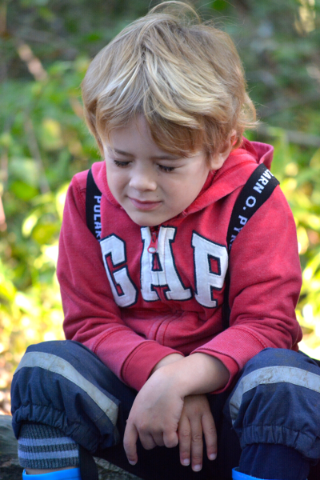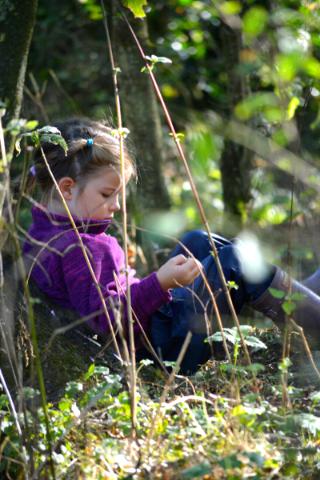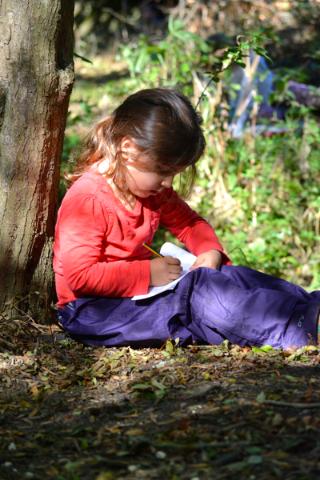-
March 2022: Year Four

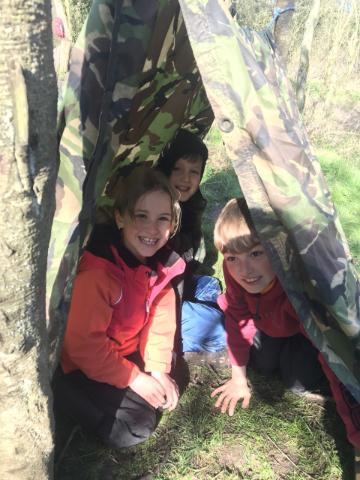
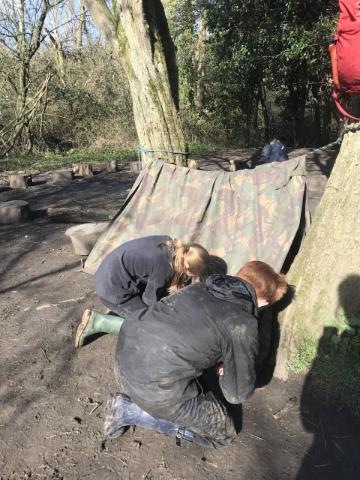
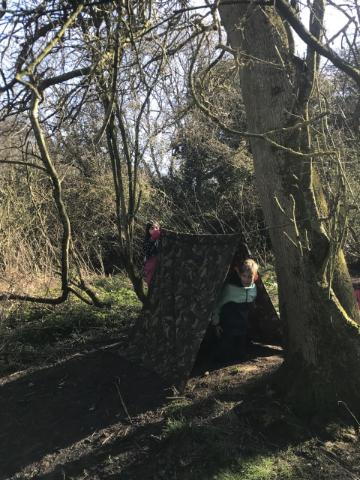
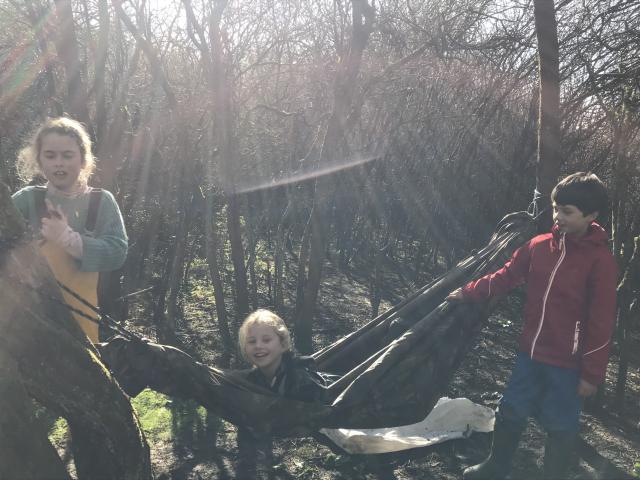
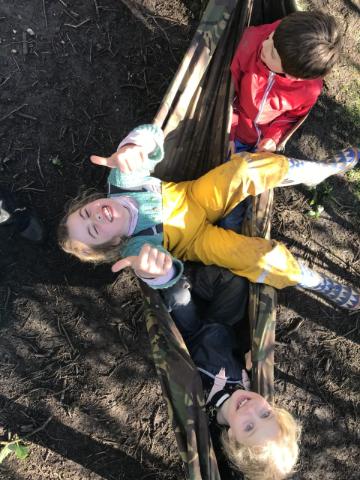





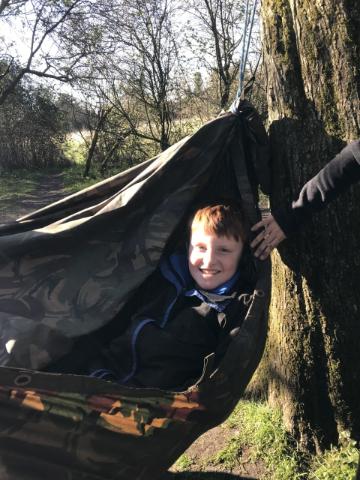
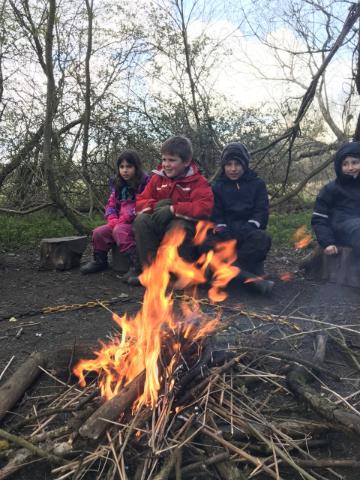



The Tempest has continued to lead the learning. They've enjoyed their Forest School fire, listening to and telling stories and making damper bread.What fun the children are having working together.
-
March 2022: Year Four

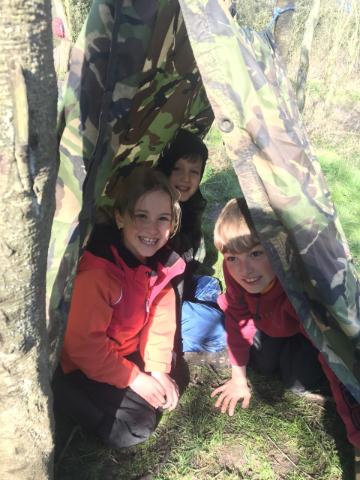
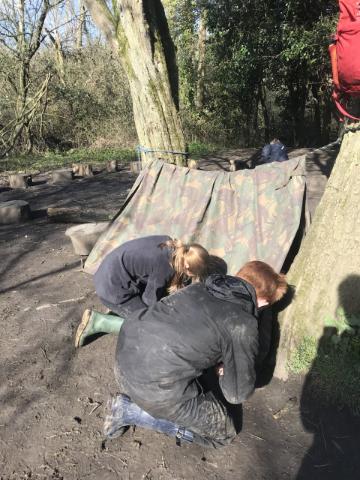
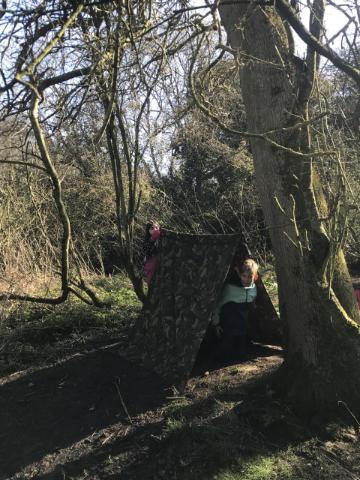
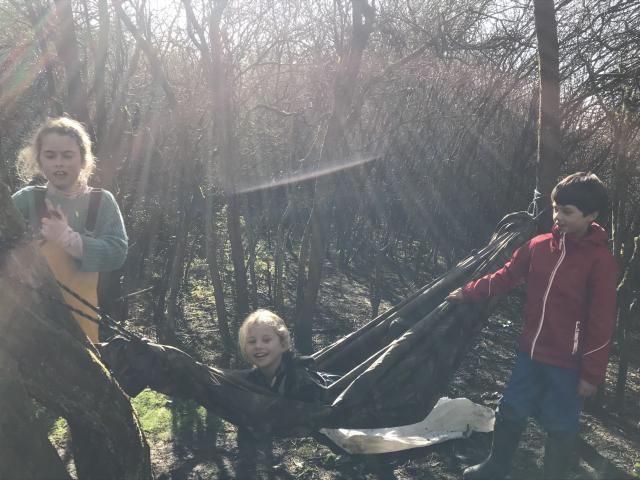
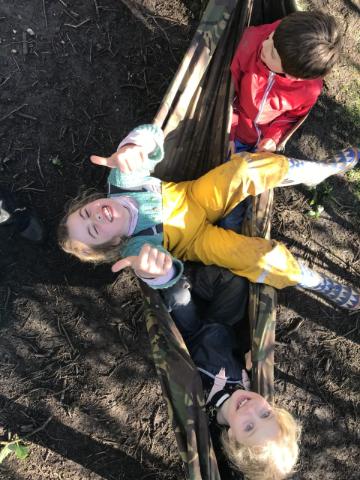

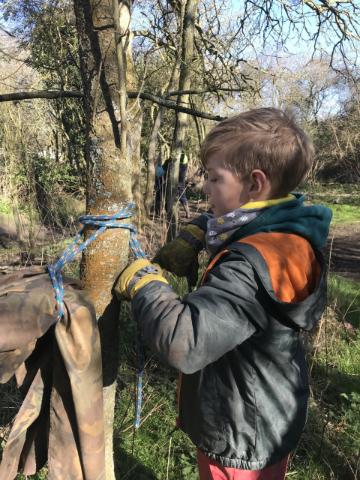
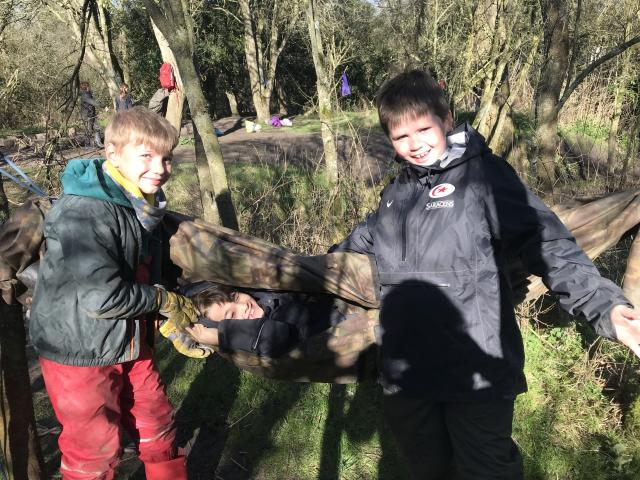
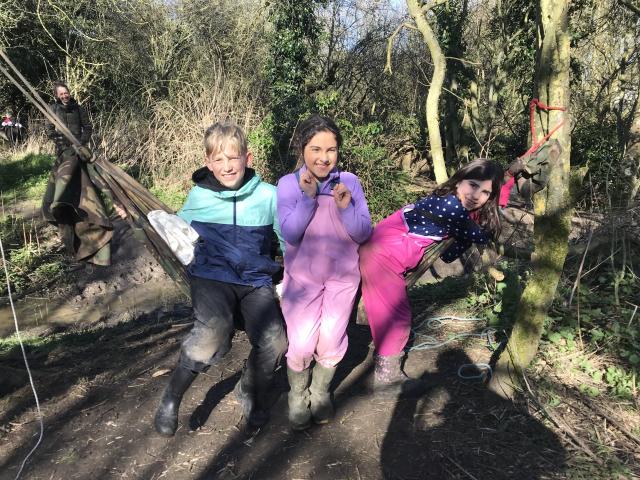
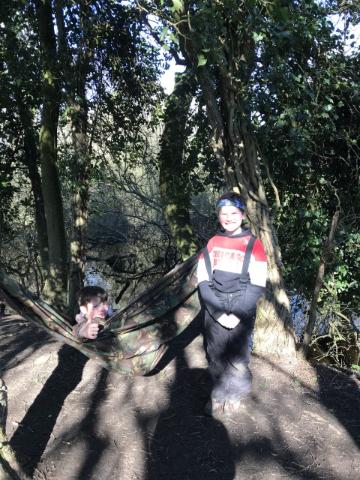
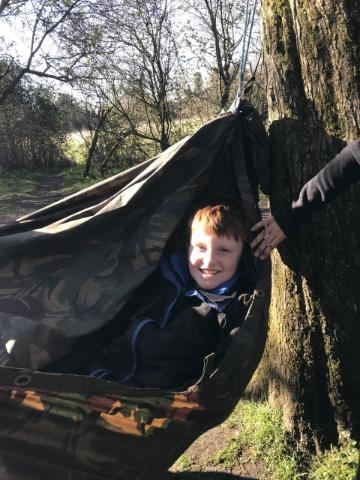
The Tempest has continued to lead the learning. What fun the children are having working together.
-
March 2022: Year Four
Year fours have been on a nature trail - collecting things and practicing knots for their wind socks. Looking a little like dream catchers, their creations did a good job of telling us the wind direction. Weekly checks on the rain gauges continue to be taken.
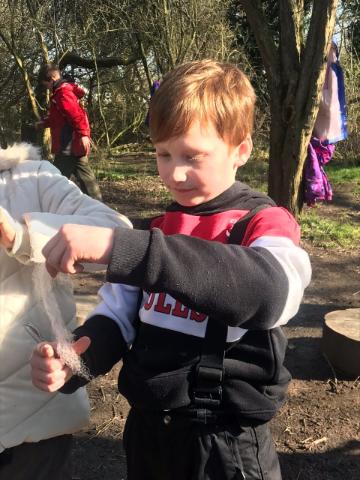
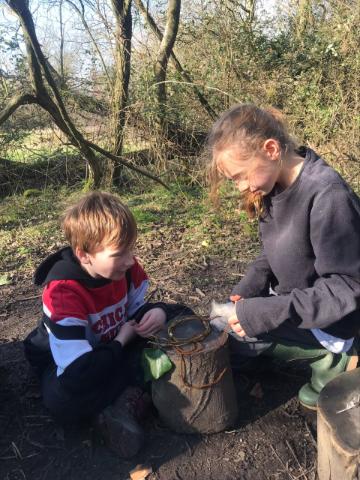
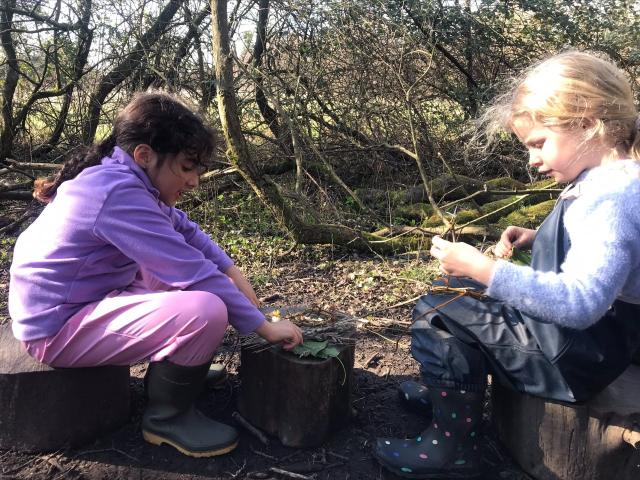
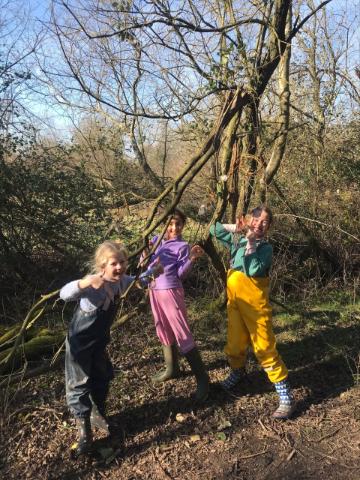


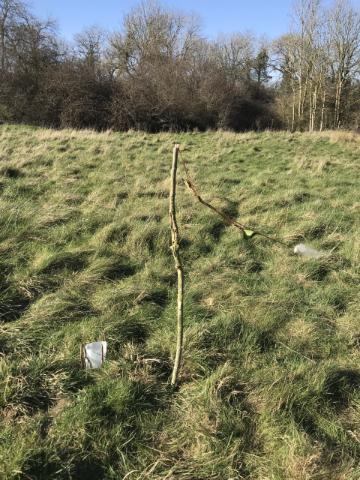
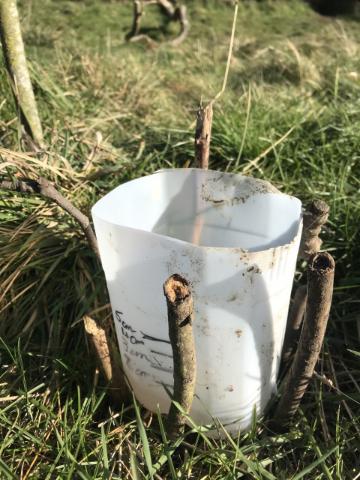
-
March 2022: Reception
Lot of fun in the water has been had - including a team race to fill up some buckets. They have also been busy planting broad beans and having fun in the mud.
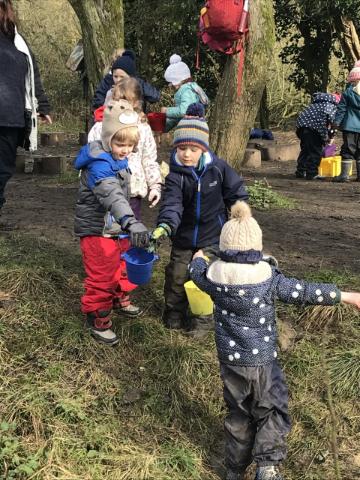
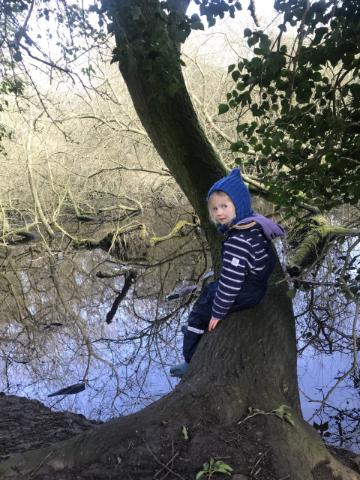
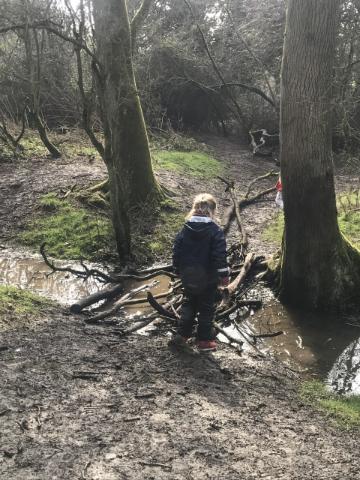

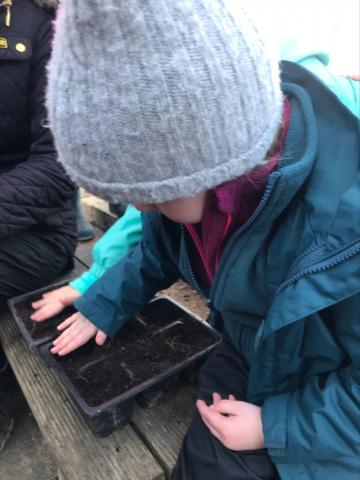
Our receptions have become experts at spotting and identifying birds.
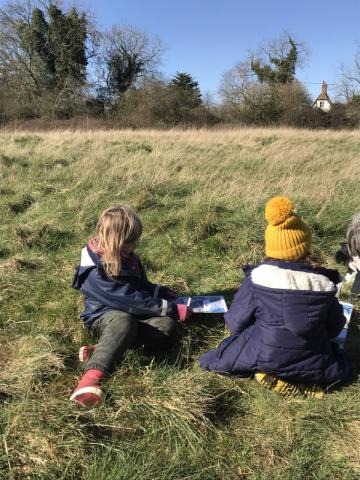
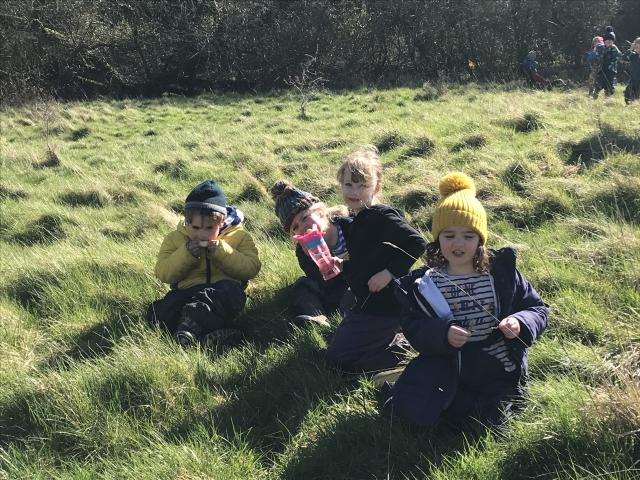

-
February 2022: Year Three
Our year threes have been making rain gauges, working on their knot skills and doing some willow weaving. Wind socks are in the making.
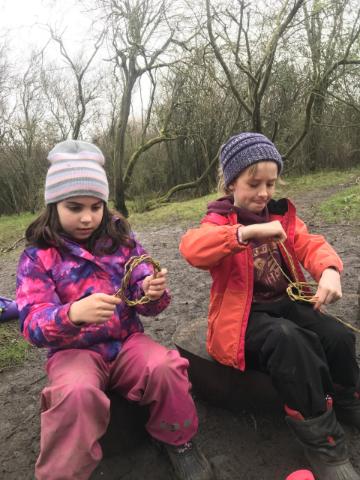
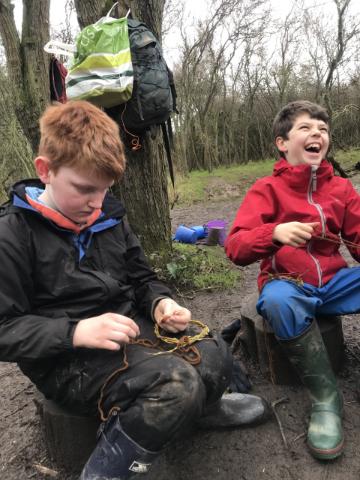
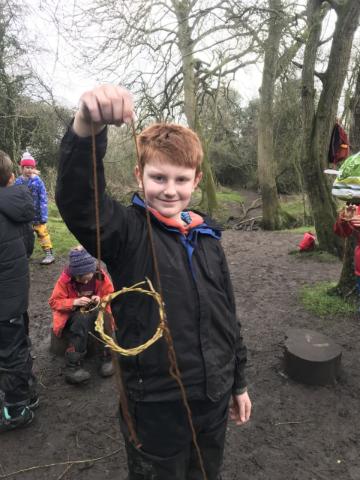
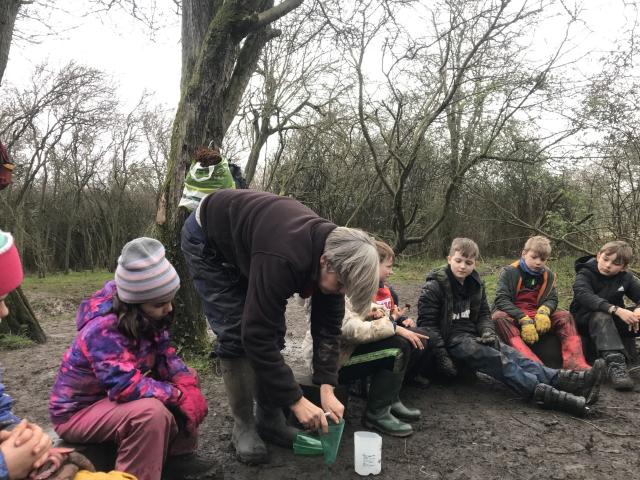
-
January 2022: Year Three
Our year threes continue to be getting better at tying knots. They have been making rafts with sails and seeing if they floated! Lots of fun with wet wellies fetching the rafts has been had!




-
January 2022: Year Three
Linked to their class learning, children have been discussing the weather - including temperature and the Beaufort scale. They have had fun discussing the Tempest and deciding what they would use if they were in a shipwreck. Using a ‘sail’ and ropes to make a shelter to survive the storm like in the Tempest were common suggestions. Children built some great bivouac shelters for a storm. Lots of teamwork was used and knot skills to build a hammock to sleep in after being shipwrecked.
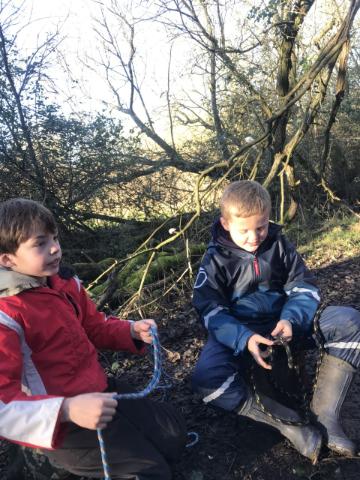
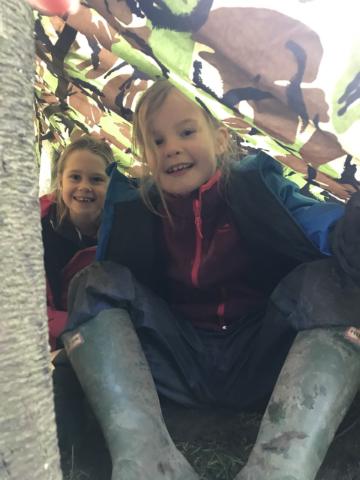
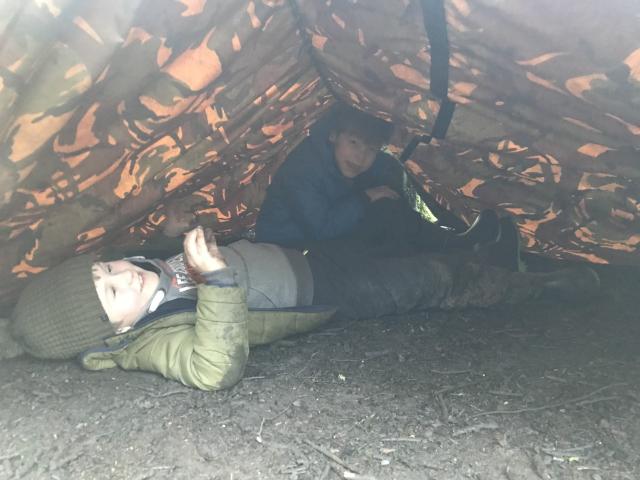
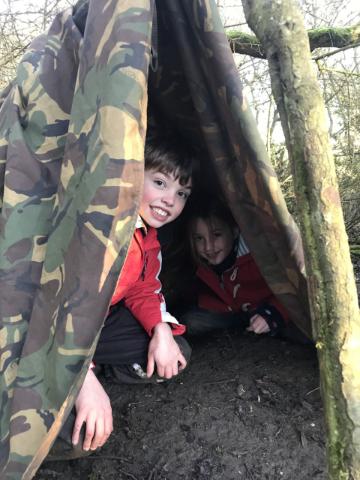
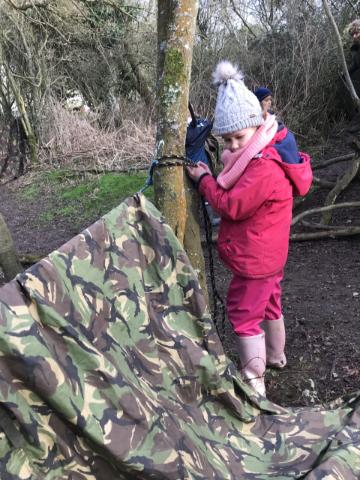
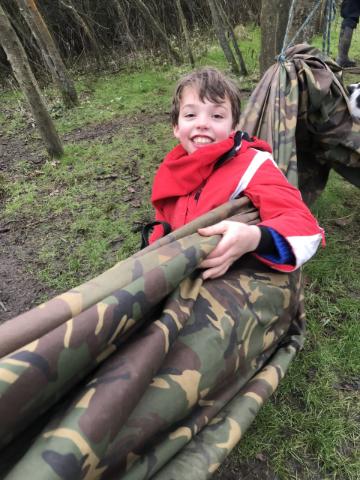

-
January 2022: Reception
In preparation for the RSPB watch, children have been working on identifying birds. They have been pretending to be birds and filling up the bird feeders ready to spot different species. Fun time was also had curling on the ice and working on their knot skills. When bird spotting, tally charts have been introduced to help them keeep a log of birds seen.
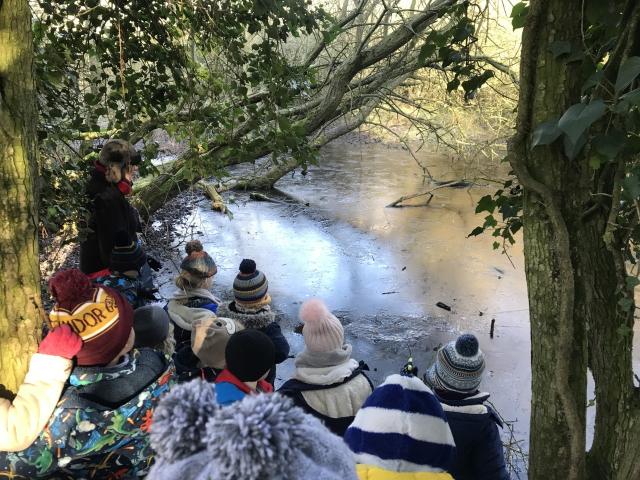
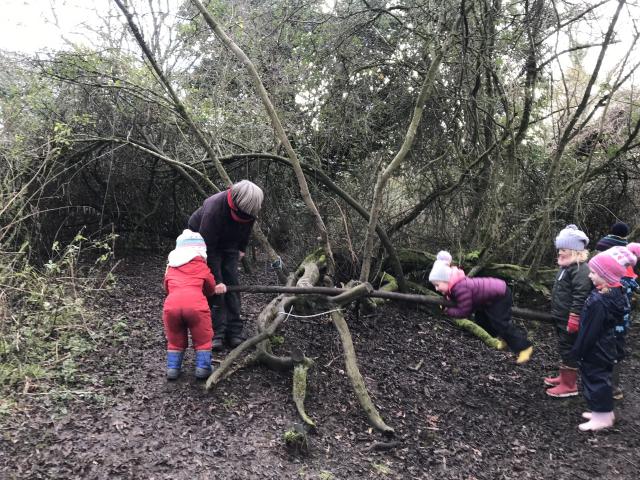


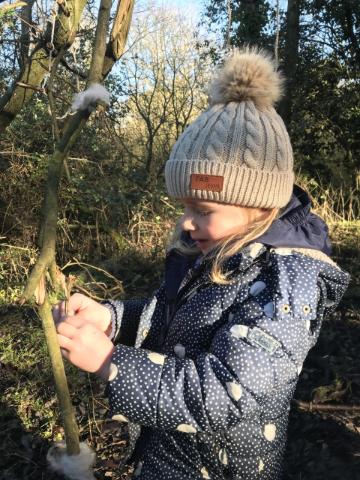
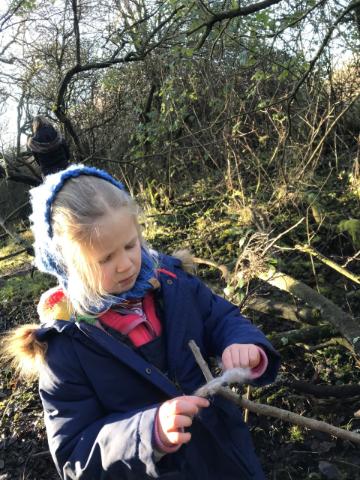
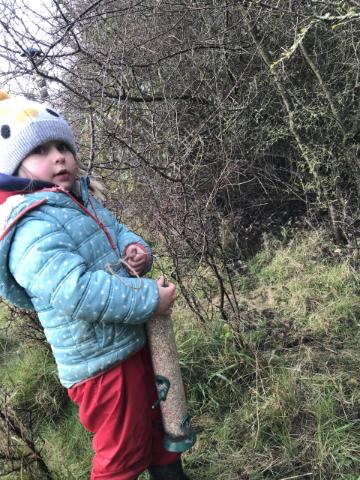
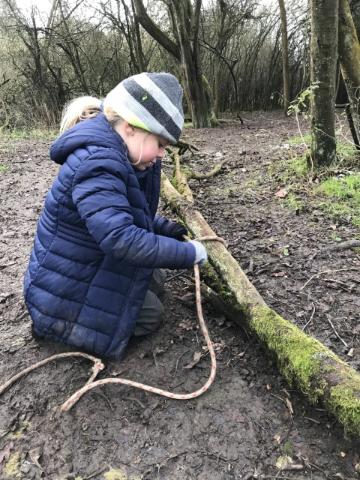


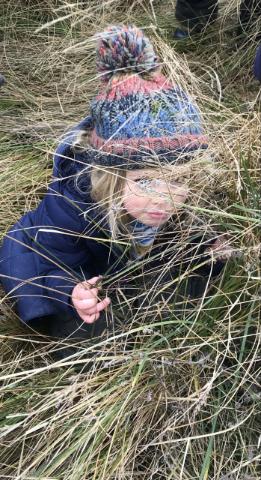
-
January 2022: Reception
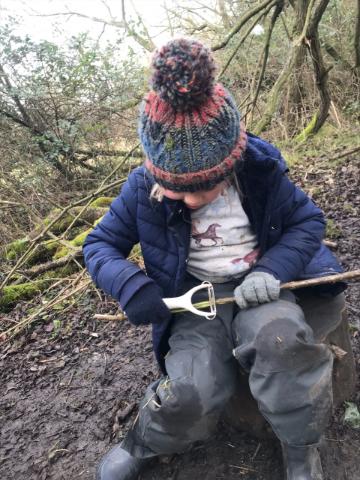
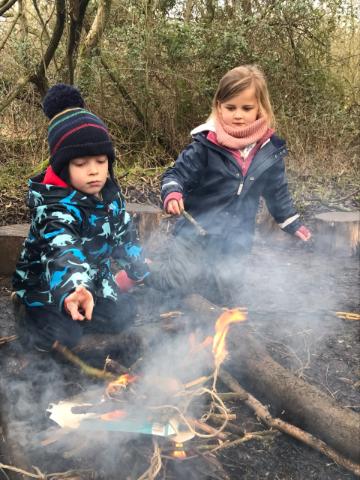
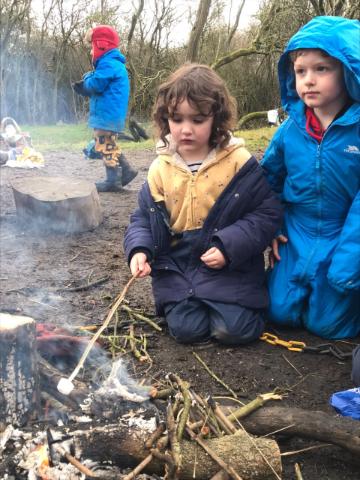
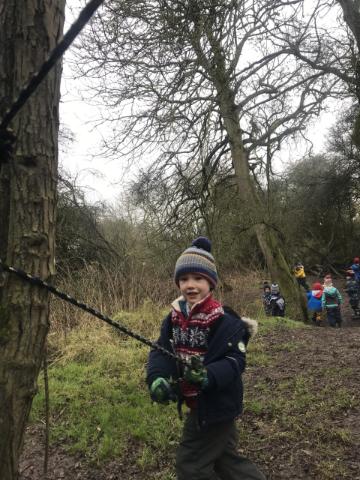
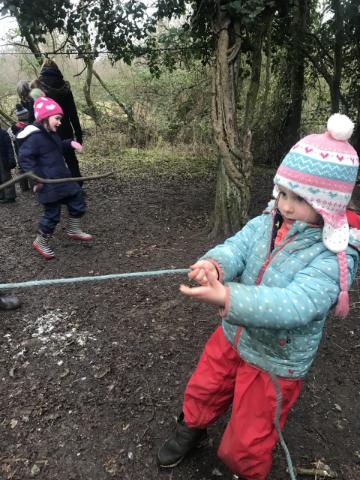

Campfire, marshmallows and looking for the first signs of spring, along with improving knot skills to put up a shelter from the rain.
-
January 2022: Year Three
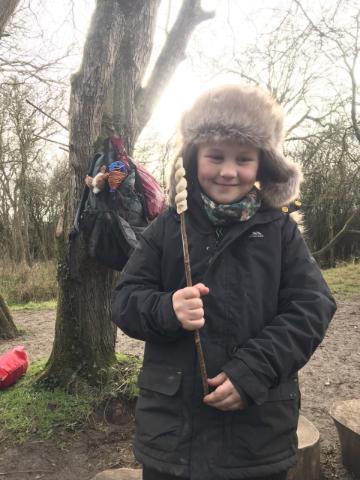

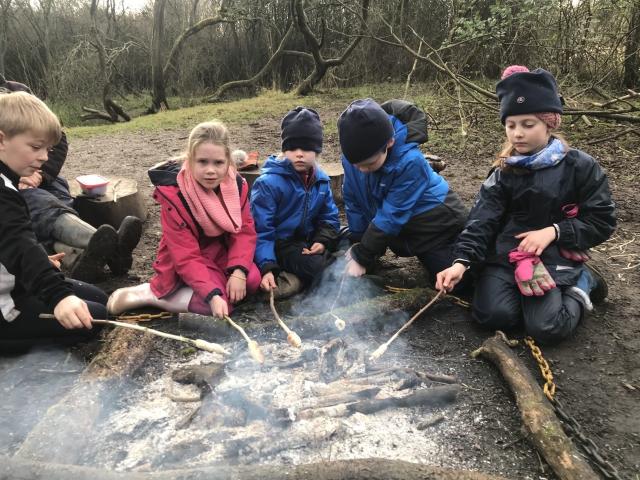

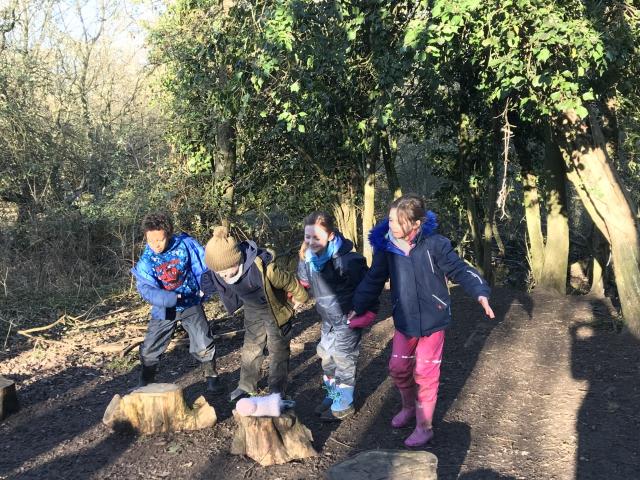
Lots of free play today and making damper bread on the campfire. Children revised how to make shelters and hammocks for a performance in groups of the Tempest. Some brilliant acting !
-
Autumn Term Summary: Reception Children
What a wonderful first term it has been for our reception children. Every member of this year’s reception class has taken to forest school with gusto. Many skills have been acquired, attitudes have matured and developed along with lots of knowledge and understanding of the world that is presented to us in the wood. Getting ready to learn outside is challenging. Everybody must dress themselves appropriately and ensure all their belongings are away ready to be retrieved at the end of the session. Observing the weather and taking note of how conditions will affect what we put on is an important skill and the children quickly learnt to test the wind with their fingers and watch what the weather was doing to the branches on the trees, observing how the colder, shortening days were causing the leaves to change and how the wind and rain brought down the autumn leaves. Getting to know our wood is an exciting and everchanging experience. All our senses are important in getting in touch. Some of the class even took off shoes to feel the trees. Finding a ‘sit spot’ of our own to return to each week was quickly established and is enjoyed by children and staff alike. Getting up high and looking down gives a different perspective as does hanging ‘upside down’ from a branch! Learning in the wood must be safe to be enjoyable for everyone (including the staff supporting the session) and through working together a code of behaviour which would keep everybody safe was devised including a come in call, safe stick play and snack protocol. Seasonal change directed many of our activities throughout the Autumn Term. Seeds, berries and nuts are in abundance and learning about them opens many avenues to explore. Colleting berries, sorting them and learning their names and which are edible (after a wash) led to pattern making, berry painting and delicious additions to the snack. The sloe berries had to be picked from on high and encouraged tree climbing, it soon became clear that buckets would be useful to collect and make ‘paint’ in. Differing grass seeds were collected one week and we measured the stems using non standard measuring tools – the height of a child. Our sessions gave us lots of opportunities to work together co-operatively. The high winds brought down large amounts of dead wood including some small trees which blocked our way through the wood – using ropes and everybody pulling together the pathway was quickly clear again. Den building in groups was also popular and it was decided that some kind of cover or net would be useful so they were added to the list of things the children decided to bring each week. The children Learnt how to fold the covers up as a team at the end of the session We enjoyed using one covered in leaves to work together to emulate the wind blowing in different directions. At opportune moments developing skills such as knotting and using a stick as a tool were introduced. A long rope tied to a tree was great for climbing and balancing.
-
December 2021: Reception
A treat from Father Christmas .... found in the woods today!
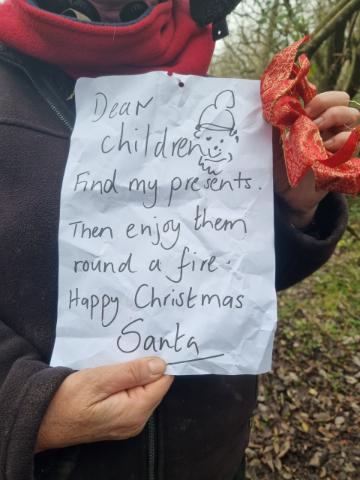
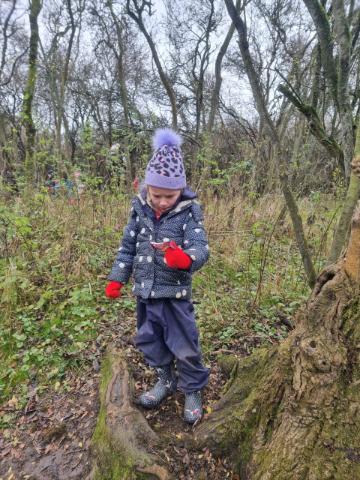
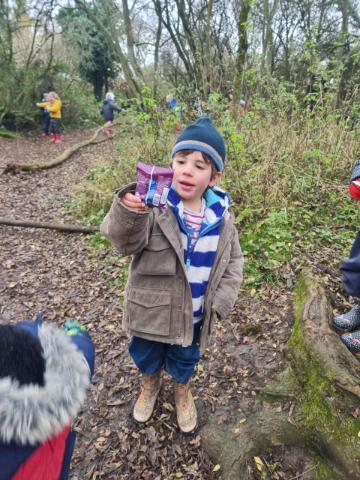
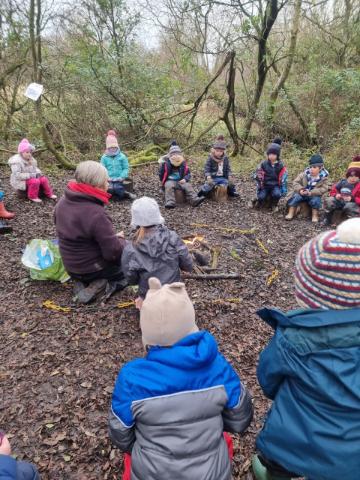

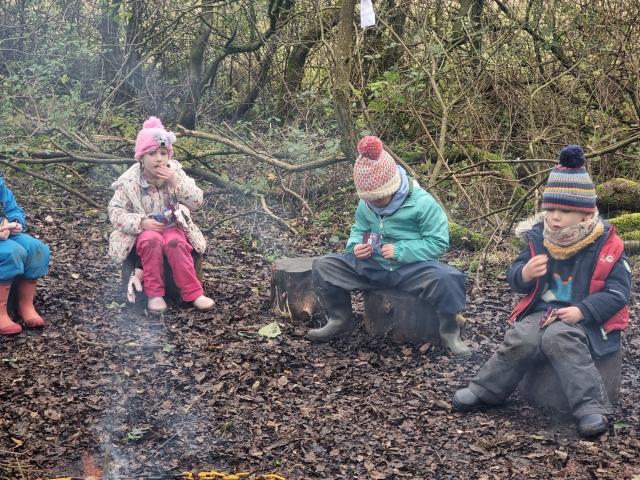

-
December 2021: Year Two
Festive Craft Workshop
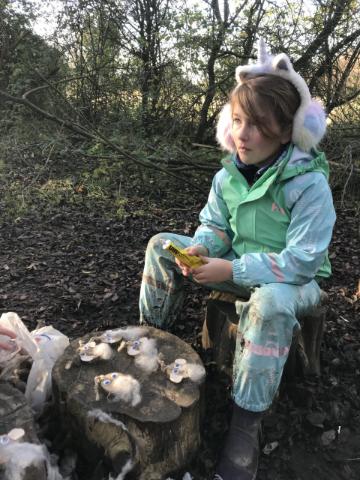
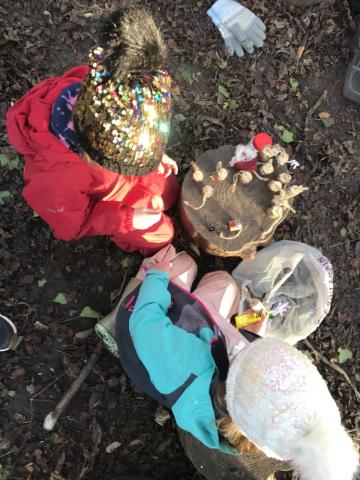
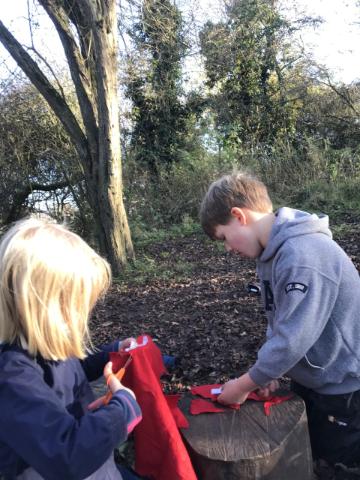
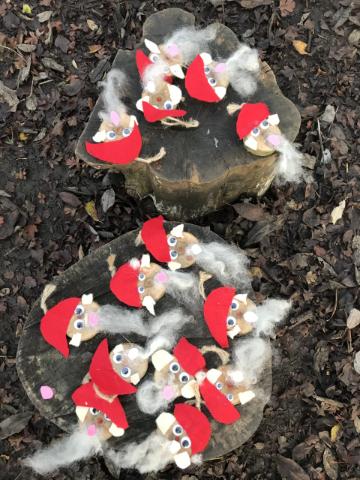
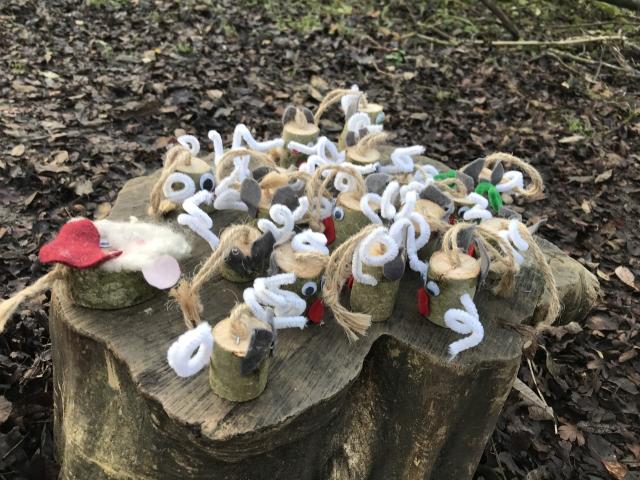
Our year two have become part of the Christmas decoration factory. They made around thirty-five decorations by becoming a production line. Groups practised using a saw producing discs and short pieces of ash wood to decorate, other groups worked on making and attaching string loops. Once all the discs and short pieces were completed groups did all the decorating including, sticking on eyes, curling pipe cleaners for antlers, cutting hats, ears and noses – they did a great job!
-
December 202l: Year Two
Den Building Fun!
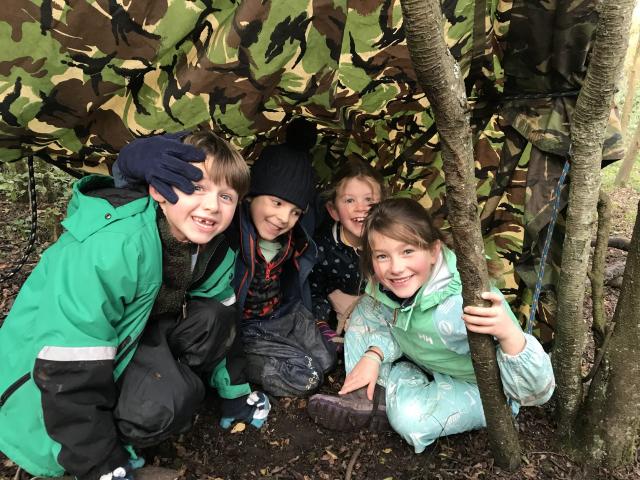
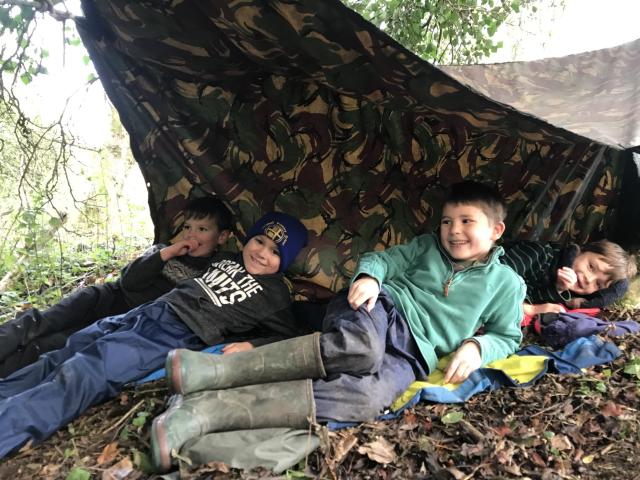
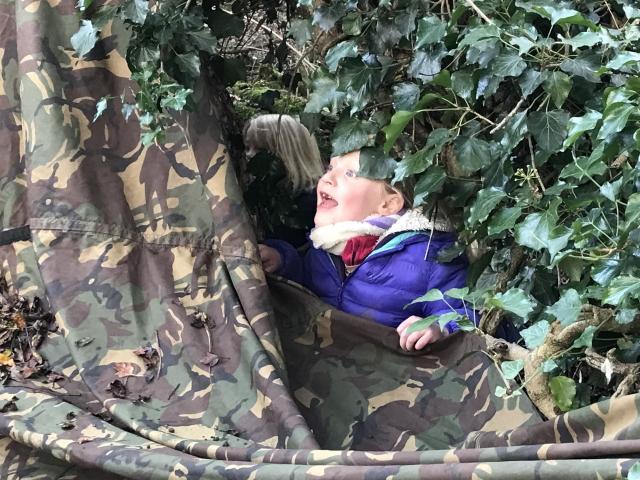
Knots were needed today as in groups their task was to make a bivouac or tepee style shelter for themselves. It had to fit them all, be hidden and not have an opening facing east or north. There was lots of looking at where the sun was in the sky to determine where north and east were!
-
November 2021: Year Two


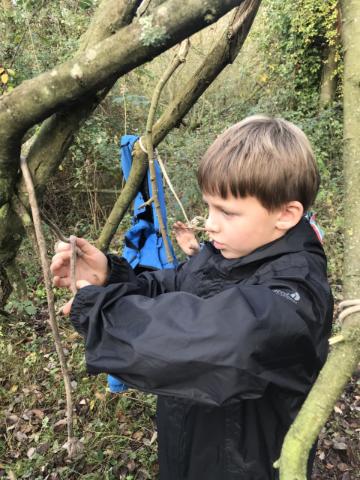
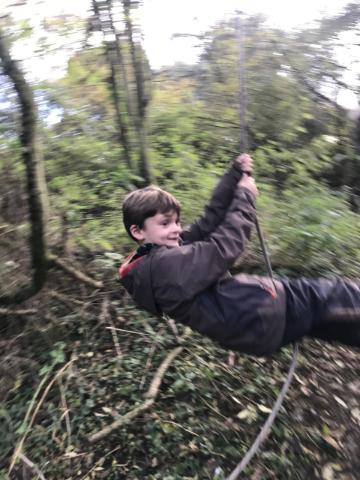
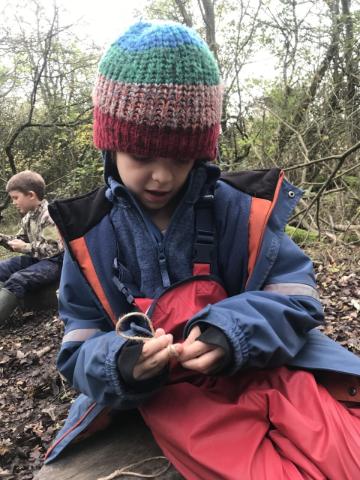
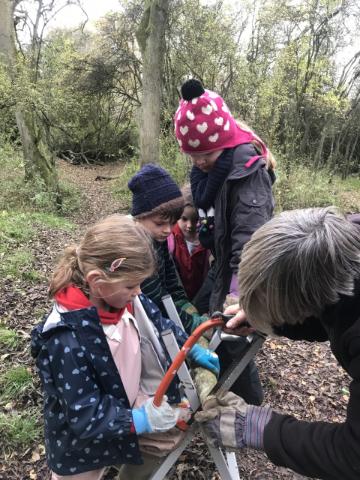
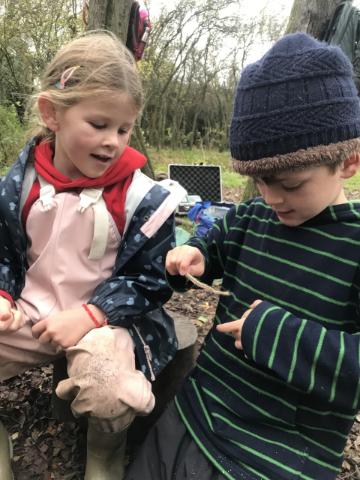
A knotty affair today (and a bit of sawing)!
-
November 2021: Reception
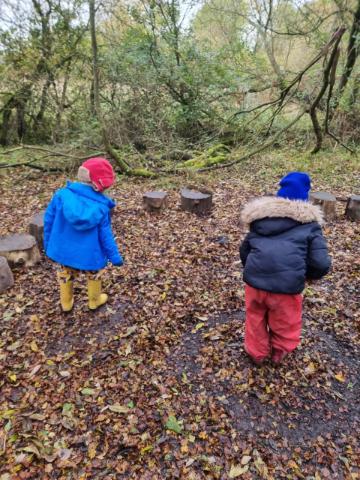
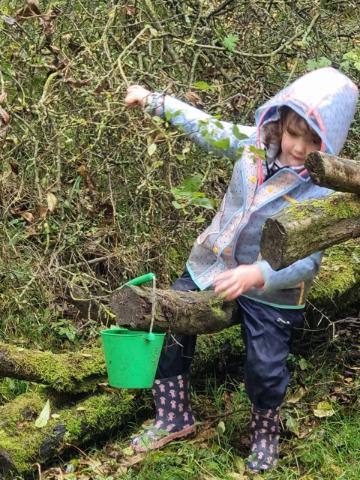
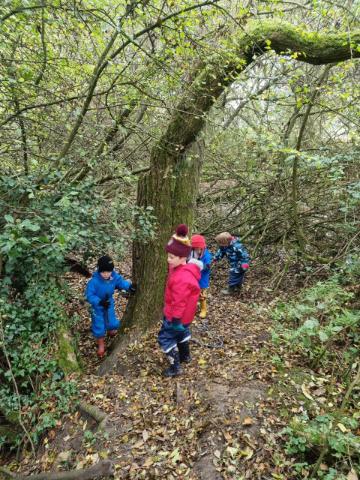
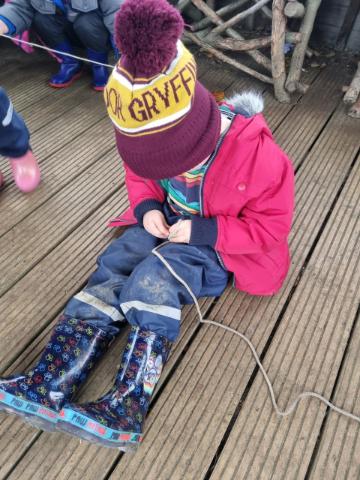
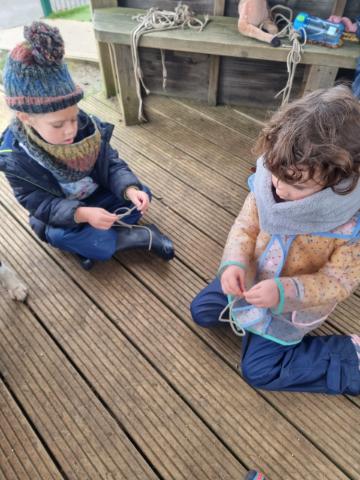
Children have been identifying different seasonal changes in the woods and have been picking up stalks from the ash tree leave bracts to see how strong they are by challenging each other to link and pull them to see which will break. Discussion was had around the need to make it a fair test next time. Everyone did a grand job in using a stick as a tool to safely clear a circle in the fallen leaves. Great concentration has been had when tying knots.
-
November 2021: Year Two
Remembrance Day
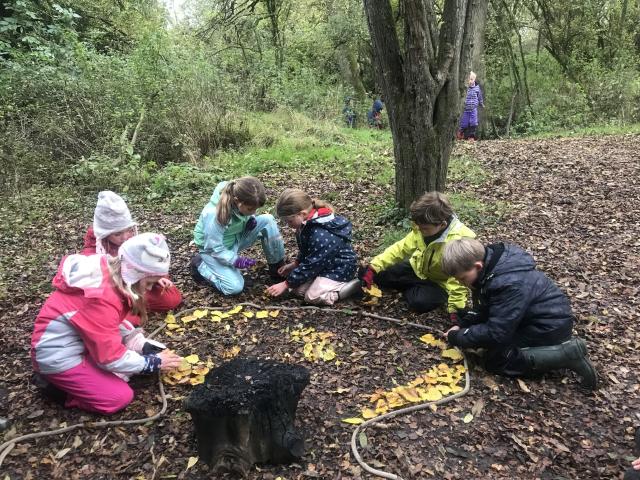
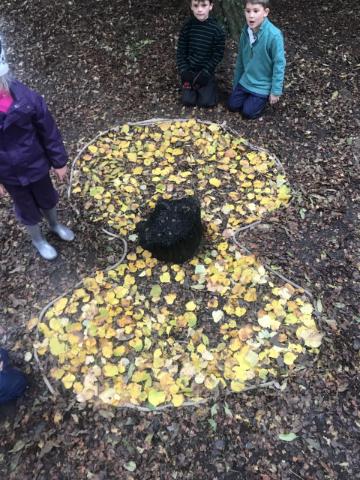

As it was close to Remembrance Day, the year twos returned to their sit spots again to think about remembrance and came to the seating circle to share and add to their knowledge. They attempted to illustrate the scale of loss of life during the two world wars by working together to create stick frames on the floor containing two hundred leaves arranged in piles of ten. They considered what a small proportion of the twenty million that gave their lives across the world wars their piles represented. The role of the flower poppy was discussed and altogether the children collected yellow autumn leaves to form an enormous poppy shape and a minute's silence was held in commemoration.
-
October 2021: Year One
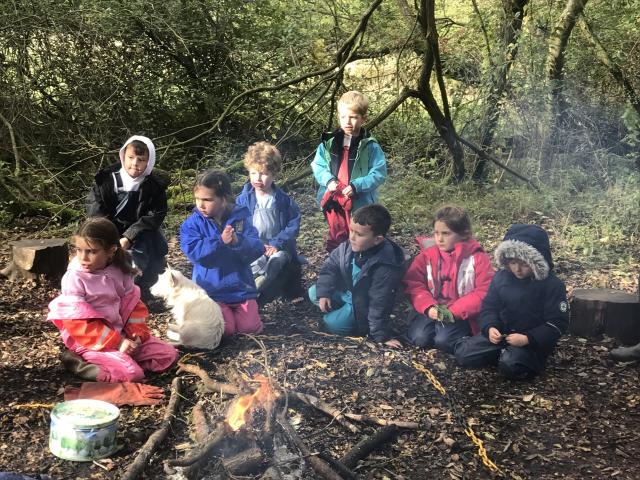
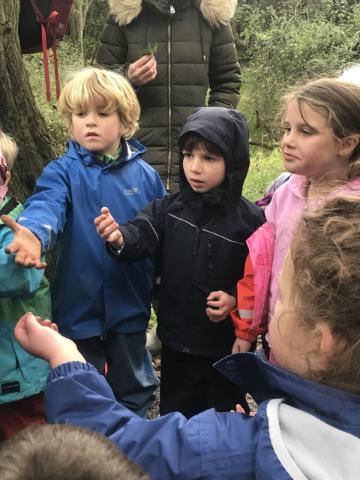
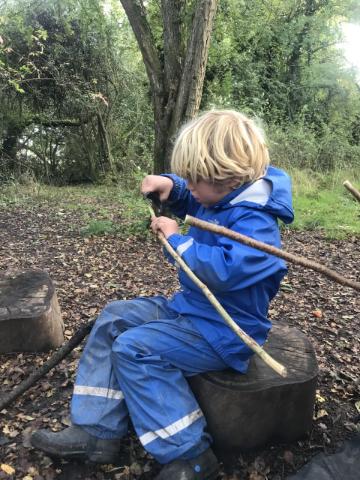
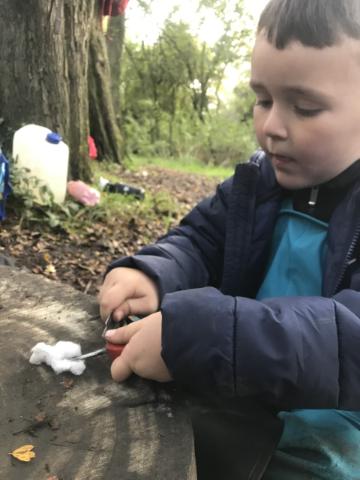
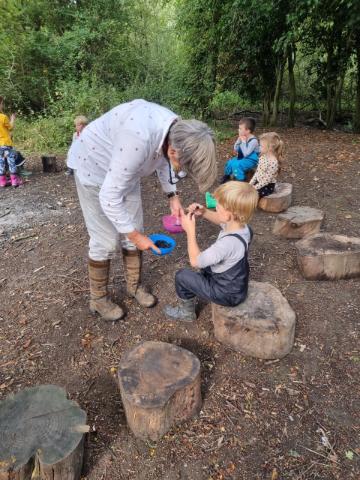
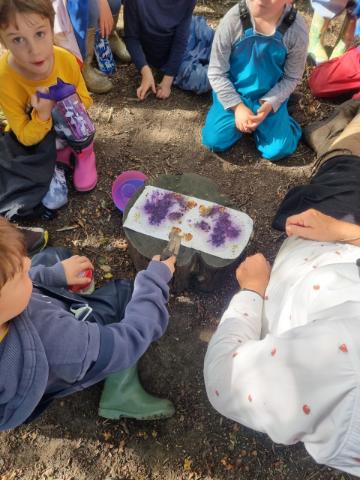
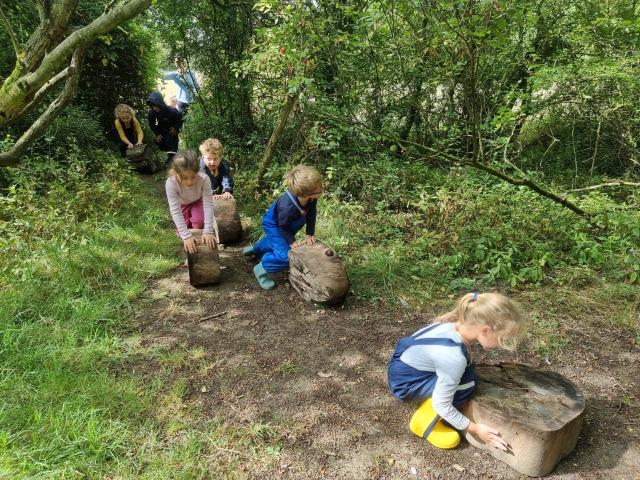
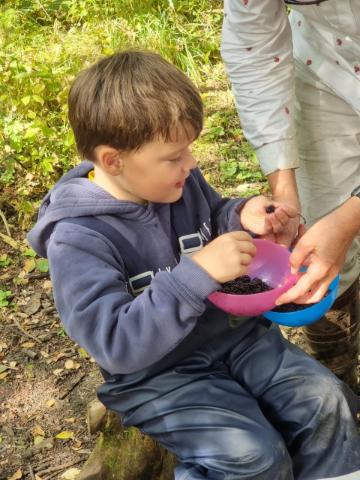
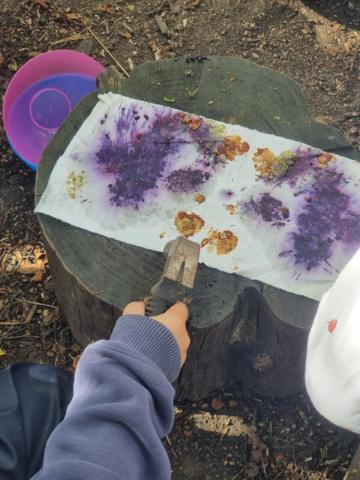
Team Work, Fire Building and Blackberries
-
Autumn Term: Reception
Our reception children have begun their forest school sessions by finding out about the boundaries when in the woods and have been finding out how to keep safe. 'Mr Ash Tree' is always used before each session to check if it is safe to enter. Children have been warned of uneven ground and stinging nettles, coming when called and always washing hands before eating anything that an adult may give them. Listening for sounds from beyond the wood, sounds from within the wood, looking for colours - golden leaves and green leaves and touching - feeling the soil, trees and using their hands and feet have helped the children develop an awareness of the woodland environment and beyond. Time has been spent establishing how different length sticks should be handled and rules for climbing trees have been relayed. Sloe berries, hawthorn berries and blackberries have been collected and children have been made aware of ones that are safe to eat and ones that are not. Throughout the Autumn Term, the children have observed the weather getting colder and that they need to wear more clothes to keep warm. When going into the woods, the children are encouraged to think about what equipment is needed - buckets for collecting things and a tarpaulin to cover stick dens and rope. Over the term, children have loved climbing trees, making a balancing rope between trees, collecting oat grass seed and fescue grass. They discovered that some were longer than the children were in height.
'Why the spider has long legs' and 'The day the sky rose above the trees' are two stories that have been enjoyed in the woods.
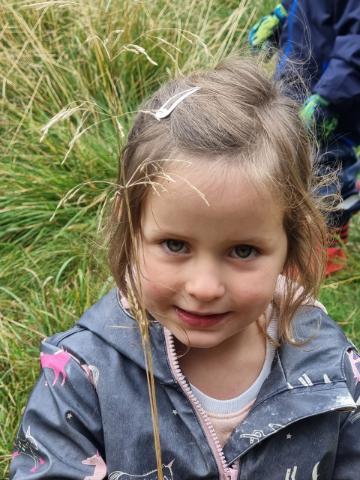
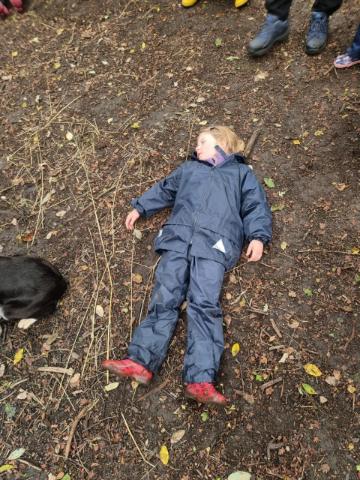
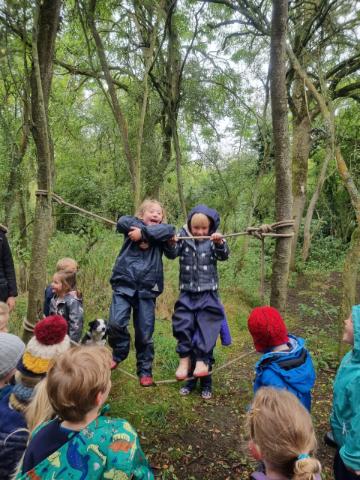
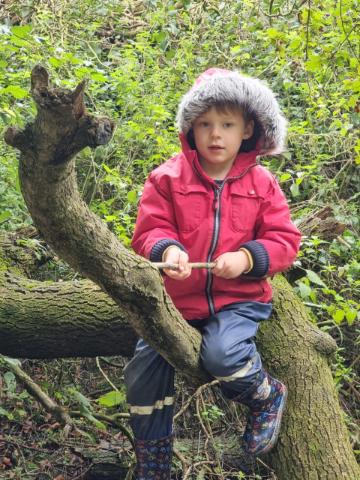
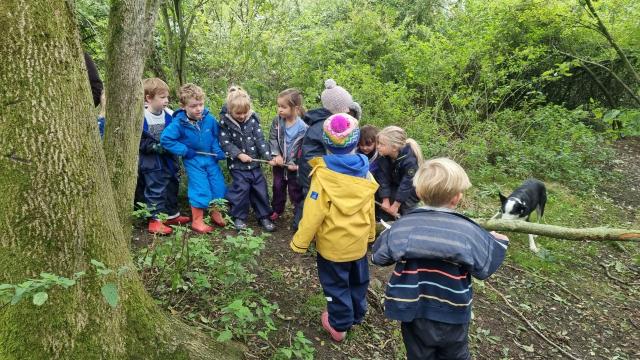

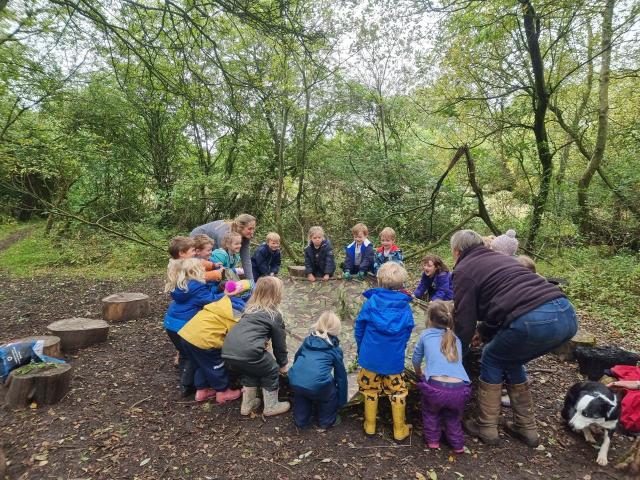
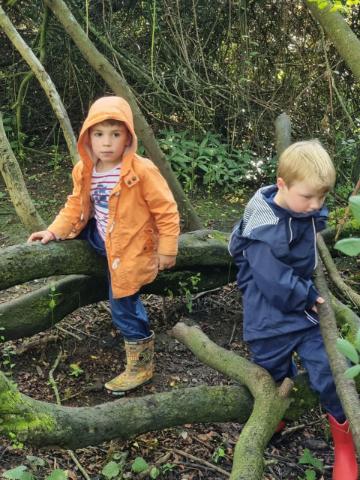
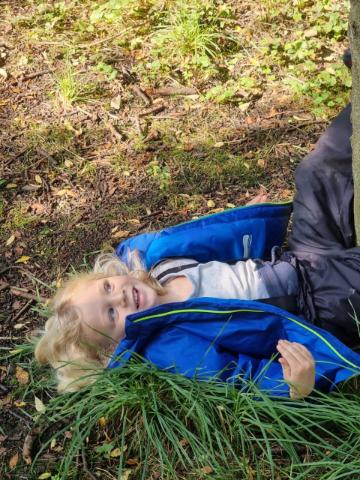
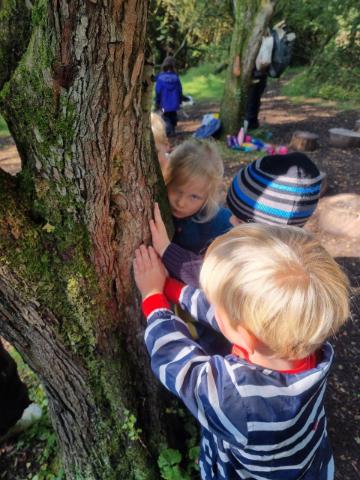


-
October 2021: Year One
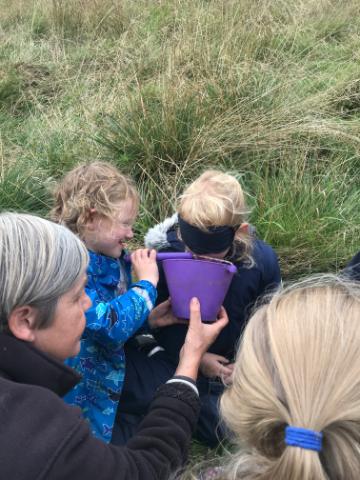

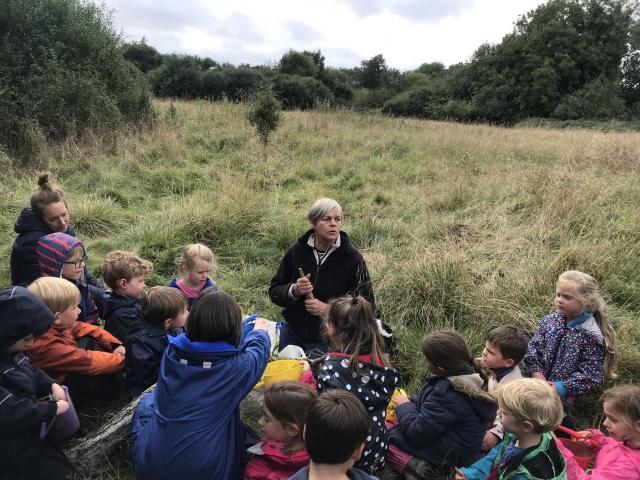
Children have collected leaves and flowers and pounded them to extract perfume. After mixing a little water to them, they did some blind sniff testing to see who could tell the perfumes apart. Some perfumes were filtered through cloth so the solid residue left behind could be seen. A combination of tools, sense of smell and working together were use this week, along with some science.
The final sessions were taken up with collecting berries to make berry leather over the campfire. It was a team effort - some of collecting berries whilst the others got the fire ready to cook them. and the last session was spent enjoying our leather along with the usual and ever popular marshmallows. Some of the members of the group also learnt how to use the fire strikers.
-
September 2021: Year One
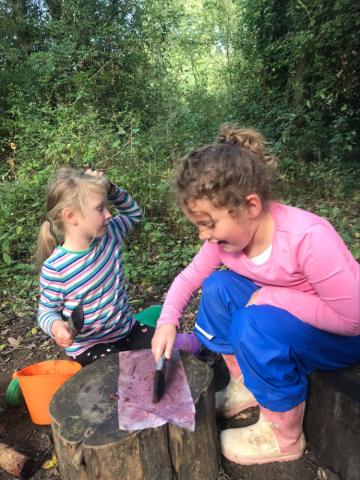
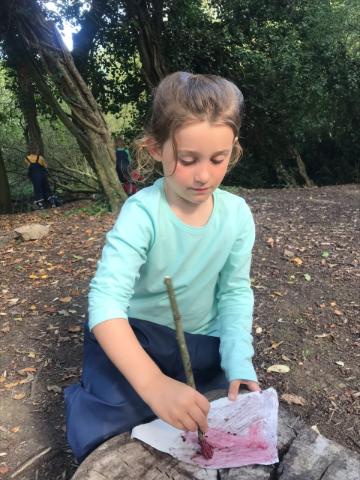

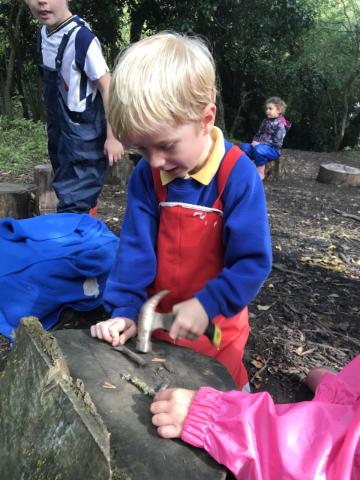
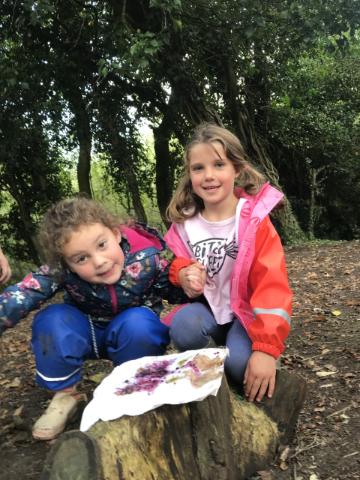
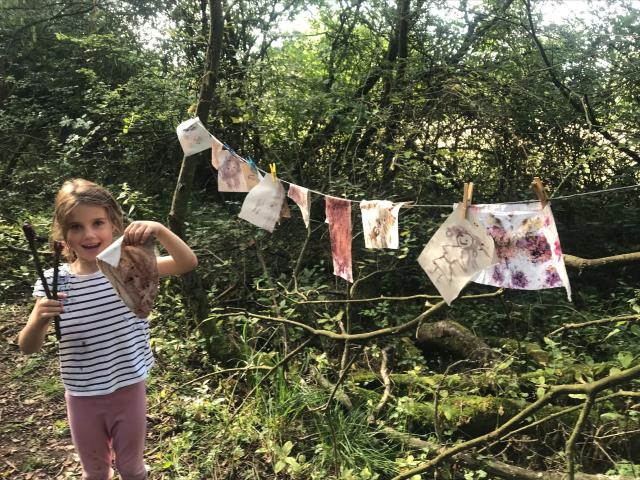
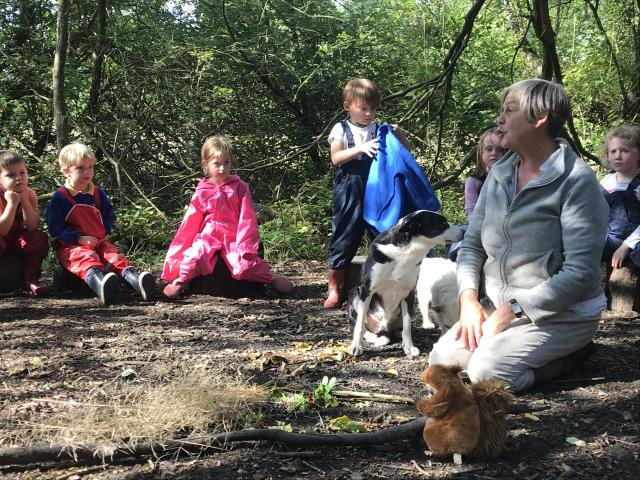
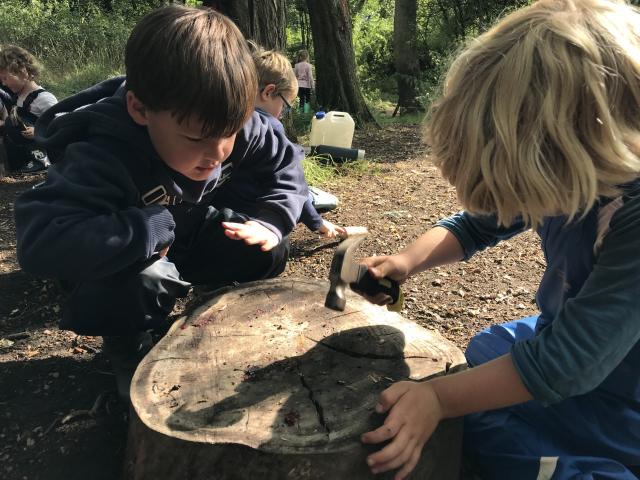
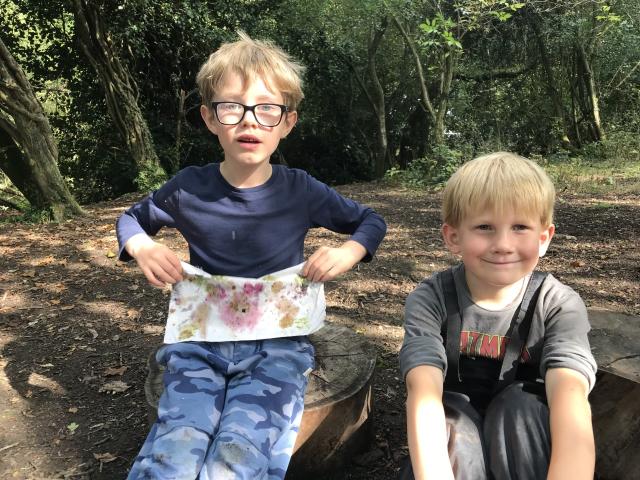
Teamwork has been a focus this term and as the first group back in the woods after the summer break they worked hard together rolling logs to put back the log circle ready for the year’s forest school sessions. Thank you Year One that was challenging work and you really ‘stuck with it’ until it was done. To work together successfully talking is important and we had a session where we led each other around the wood where one partner blindfolded so verbal communication had to be good to avoid tripping up.
Before going into the woods, the children assessed the danger by seeing how much the trees were moving in the wind. They have been introduced to mallets and hammers to hammer dye onto fabric using seeds to make symmetrical patterns. Moments of reflection have been had as time has been spent observing their surroundings and noting any seasonal changes. Discussion was had around different animals that live in the woods and what the woods provide for them. Having realised that many of the animals ate the blackberries, they enjoyed some themselves for their snack. Seeds have also been collected and classified.
-
Rescuers and Rescued Climbers on the Hill
Rescuers and Rescued climbers on the Hill
This great game was created by the children. It involves them all and uses many of the skills they are encouraged to learn at Forest School.
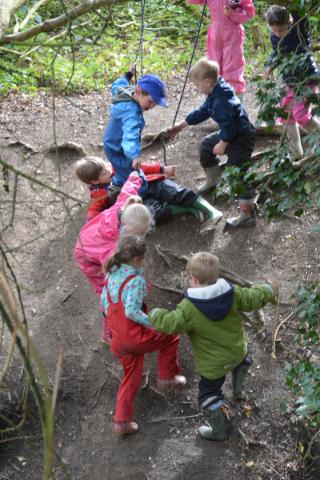
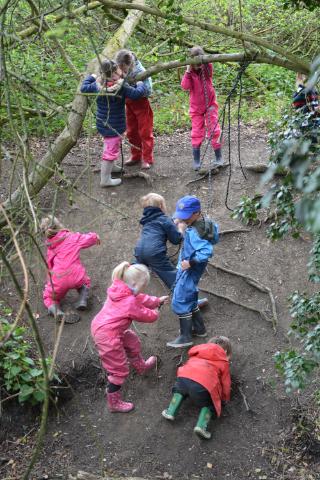
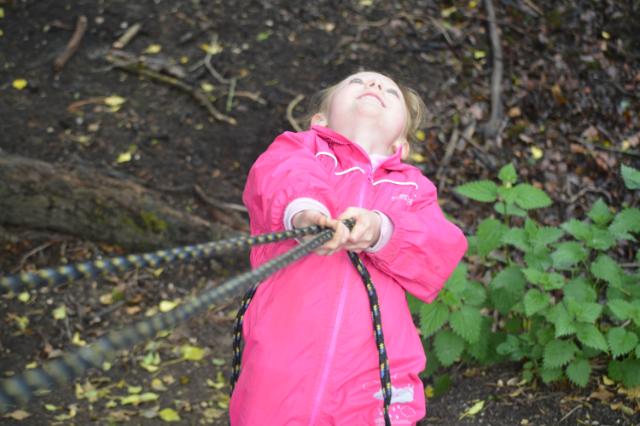
Over the weeks the game has involved everyone. They are either being rescued or doing the rescuing. The roles seem interchangeable. All of them work together to fix ropes to the protruding roots so they can be used to help each other up the hill. The children recognised the need to tie good knots and as a warm up activity one week – everybody practised at circle time.
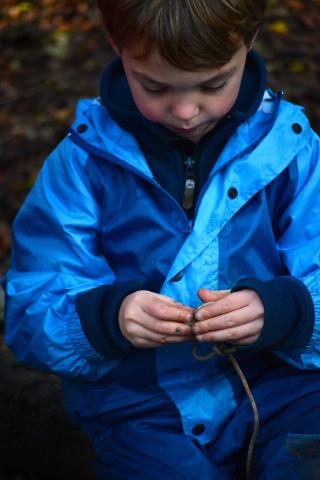
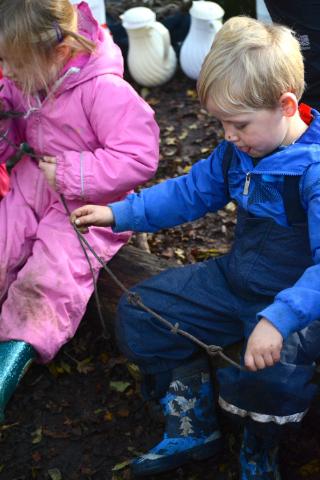
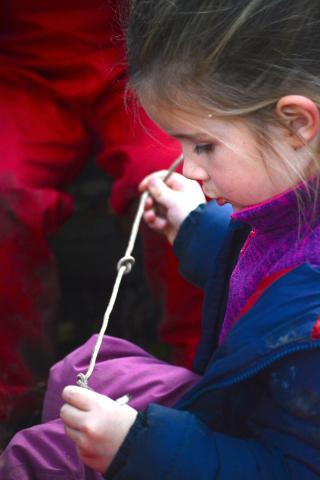
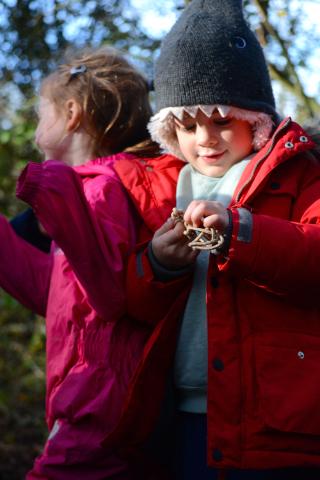
Once rescued or the job of rescuing is done for the day, refreshments are available made, by some members of the team, in the plastic buckets. Chocolate cake and drinking chocolate are often on offer.
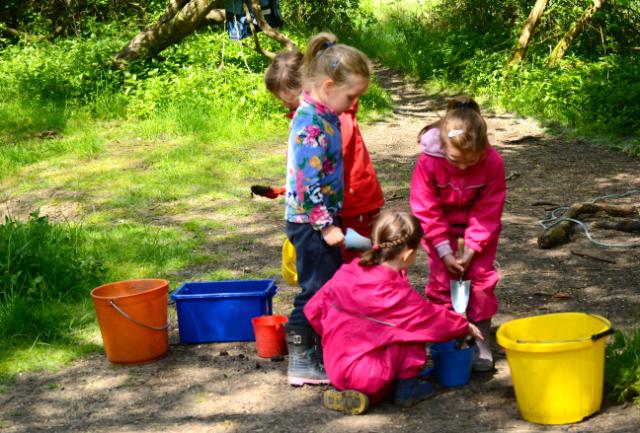
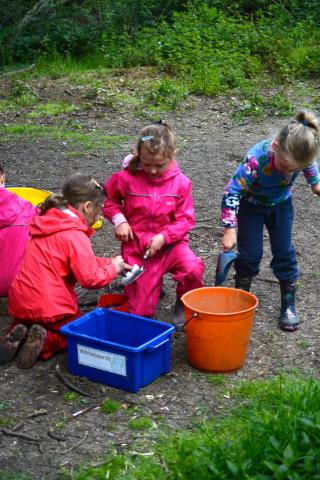
-
Young Archaeologists discover 'Dinosaur Bones'
Young Archaeologists discover ‘Dinosaur Bones’
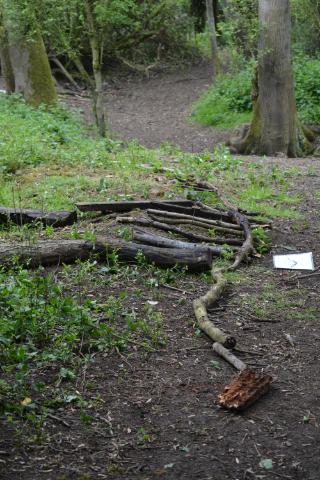

Teams of young archaeologists have spent the last few weeks digging and discovering. Working together they have excavated pits in different parts of the wood and carefully categorised their finds – some real fossils were found.
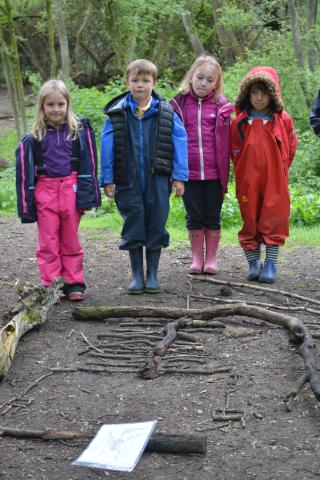
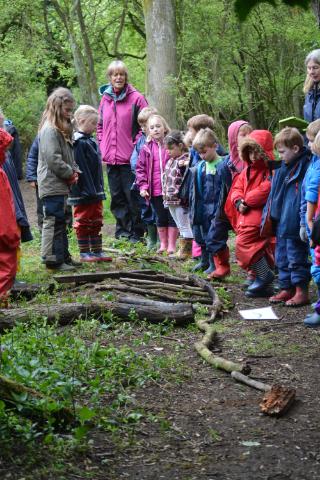
After much hard work each team pieced together stick dinosaur skeletons and when the ‘Natural History Museum’ opened there were, three Tyrannosaurus Rex, a Diplodocus and a Pterodactyl on display.

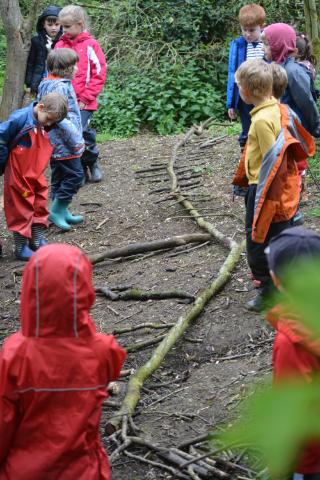
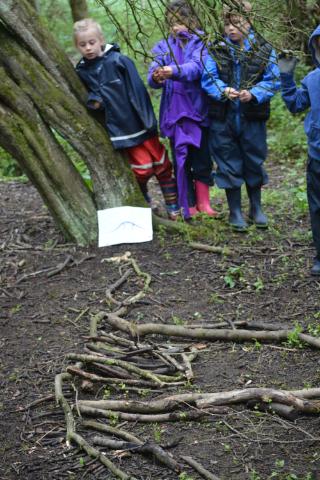
-
Seasonal Ponds – water, mud, working together and learning about changes
Seasonal Ponds - water,mud, working together and learning about changes
The late winter rains filled the seasonal pond in the wood. With the water came opportunities for the children to play and learn in the shallow pool and the muddy margins.
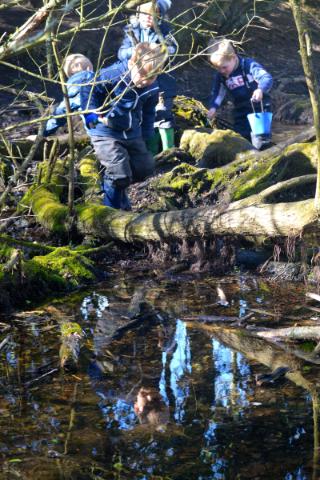
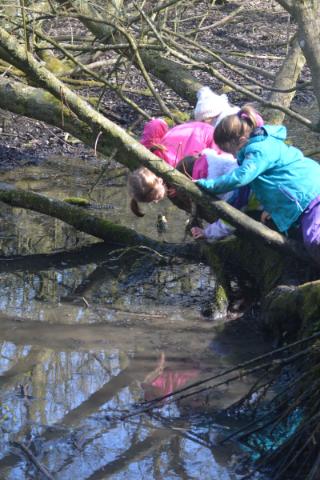
Splashing, mixing, filling containers lowered into the water from the bending willow trees and looking at their reflections, were all activities the children enjoyed, The water was also a fleeting home to spawning mature frogs who were spotted and watched by the children.

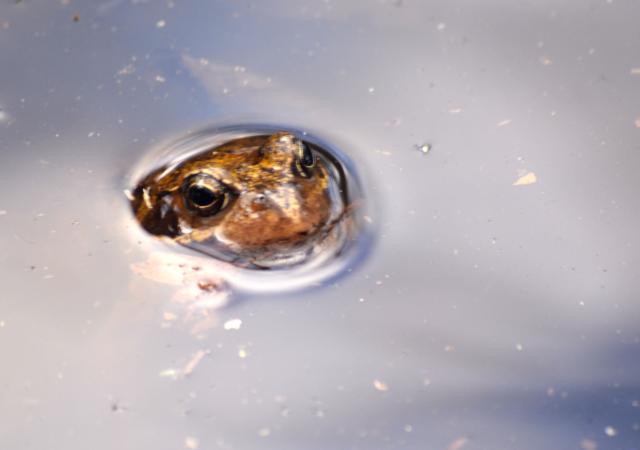
The muddy peaty margins, always sticky, became cloying as the weather dried the pond. The resulting mud became a favourite digging and building material. Much hilarity ensued as the children freed each other from the mud – rescuing many a welly. Some children who had been a little uncomfortable at being so covered in mud became quite used to it.

Week by week we have watched the pond dry and changes were observed. Some questions were asked about where the immature frogs would manage to find habitat. A question answered when many of them were found in the long wet grass in the meadow beside the pond. Frog stories explaining metamorphosis were told in story-time.
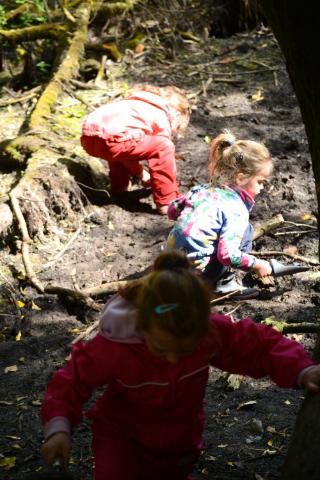


-
May Morning
Spotted at Forest School one sunny morning in May
Last week was a super time for spotting birds up close, admiring the hawthorn bushes that were in full bloom and finding willow seeds that had been spread far and wide.

As we walked to the wood a kite soared overhead.

A pied wagtail nonchalantly hopped about – wagging his tail – looking for food in the grass.

Inside the wood, willow seed seemed to fill the air. Drifting past us as we sat in our sit-spots, filling hollows in the ground and catching on cobwebs and twigs then sparkling in the sun.
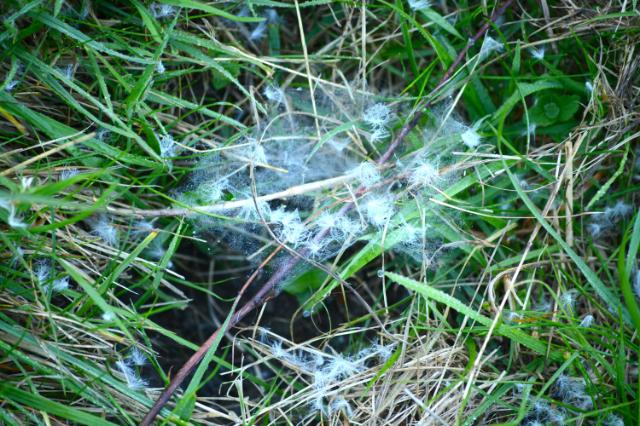
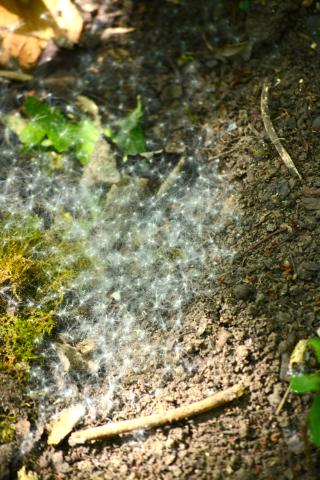
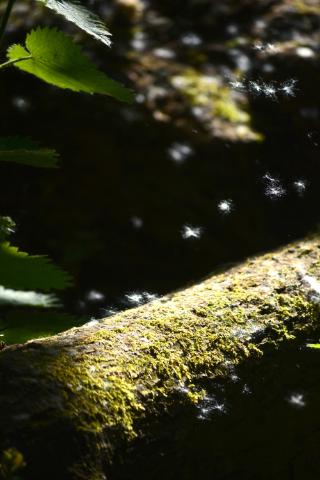
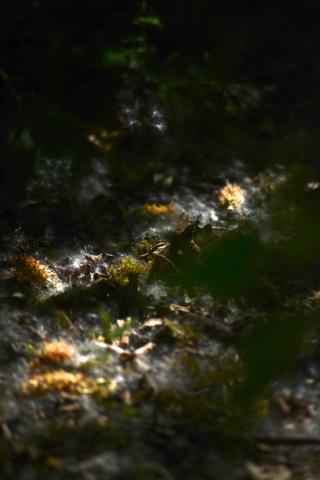
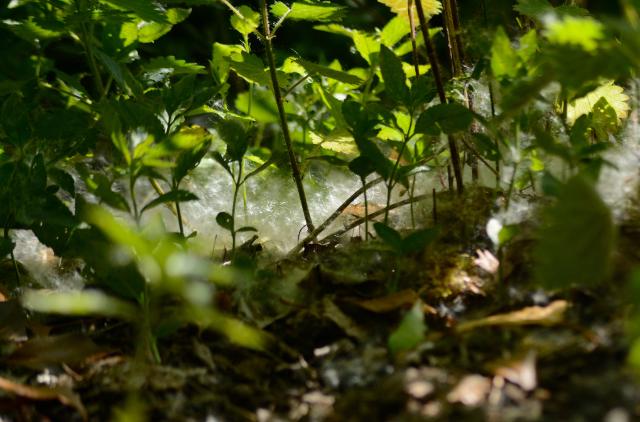
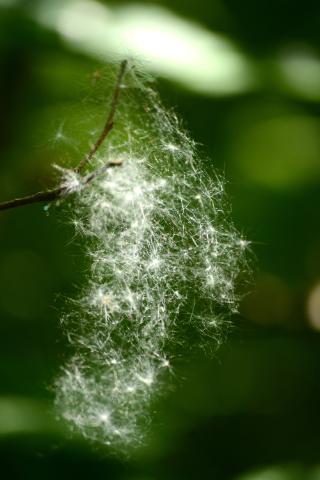

A big thank you to our photographer for catching these moments for us.
-
Spring
Seasonal Change – Observing and Learning the names of plants signalling Spring is coming
As the season turns from winter to spring plants begin to grow and flower indicating the changing season.
To help children spot these plants emerging and learn their names actions and dramatic voices are fun to do:-
Snowdrops – Galanthus
On sighting these early spring flowers with their dropped heads. Children can be encourage to call snowdrop and then drop their own heads and stretch our their arms to show how the flower drops below the level of the plants leaves.

Lords and Ladies -Arums Maculatum
Are also known as Lords and Ladies – so the children can unfurl an imaginary cloak to go with the plant’s unfurling leaves and then bow as a lord would to a lady.
Hazel catkins – Corylus
The hazel catkins resemble lambs tails and the children can ‘bounce and wiggle’ like spring lambs.
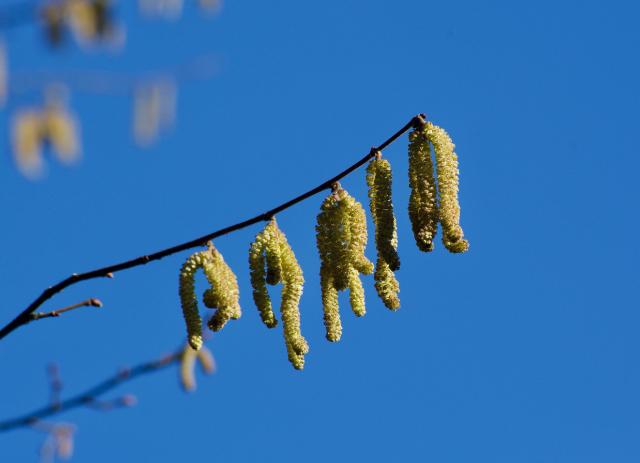
Dogs’ Mercury – Mercurialis perennis
These green leaves with their non de script white flowers simply have to be barked at.
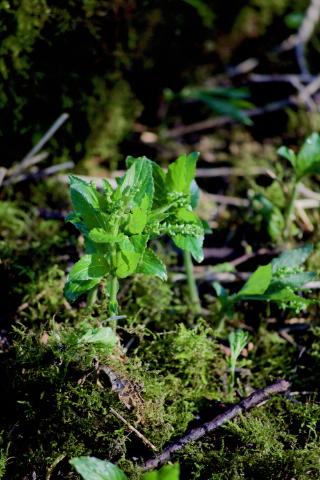
Later in the spring as the daffodils (narcissus) open and the cleavers (Galium aparine)climb through the emerging nettles -imaginary trumpets can be blown to represent the daffodils’ corona and the children stick to each other to pretend to be cleavers.
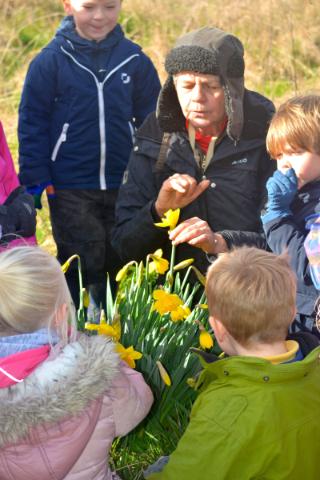

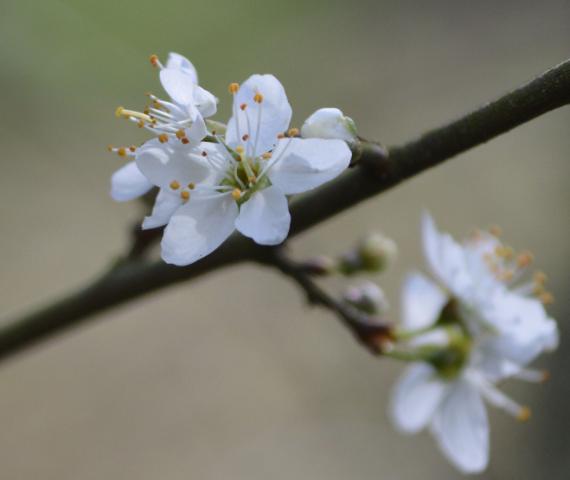
-
Topic Work and Forest School - The Ancient Egyptians
Using Forest School across the curriculum - Ancient Egypt
The pictures show our current class of mixed Year 3 and 4 children, many of whom have been at Chrishall since their reception year and are experienced forest schoolers. As reception children they attended forest school sessions weekly and in subsequent years have had half term long blocks of weekly sessions.
Aspects of their topic on Ancient Egypt were covered during their current forest school half term block. The forest school ethos informed everything the children did and in the middle of one session there was a prolonged snow storm and the only "proper" thing to do was play in the snow. That may seem a long way from the desert, but the Egyptians did use sledges on the sand (see our pictures of working together).
Working Together
Moving heavy new logs for the circle on tarpaulins. The ancient Egyptians slaves dragged the stones used to build the pyramids on sledges across the sand.


Playing with Nature
Using found materials to construct square based triangular prisms making pyramids of various scales – some even fit a ‘mummy’!

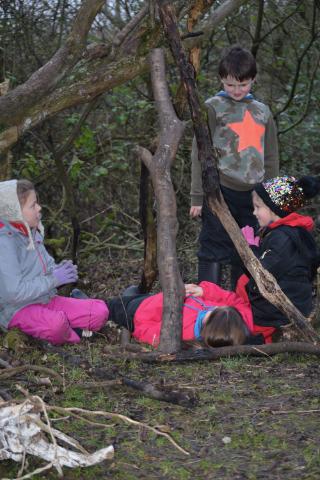

Using the contours of the woodland floor
Each group worked together to make a river – possibly the Nile. Lots of their geography and science knowledge was put into practice here to make their rivers flow when the rains came (a bucket of water out of the pond).
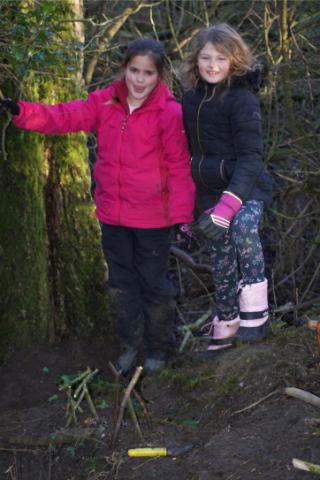
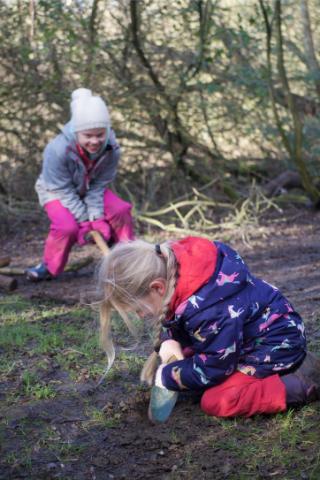
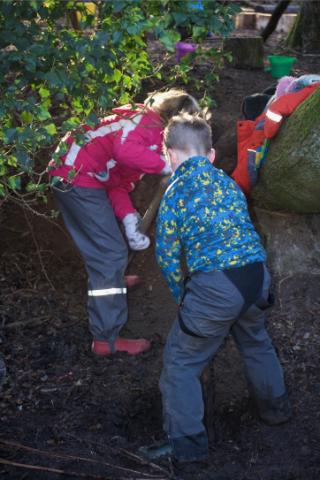
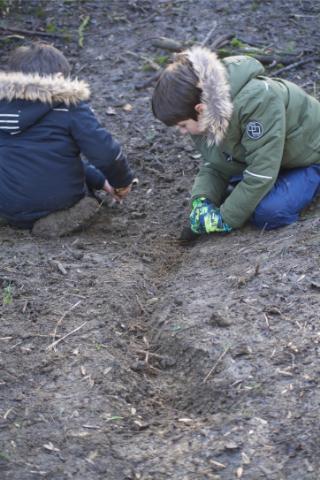
Skills
Knots were learnt and practised over several weeks, then used along with sticks to answer the challenge – Make a shaduf that can lift a bucket filled with water through at least ninety degrees.


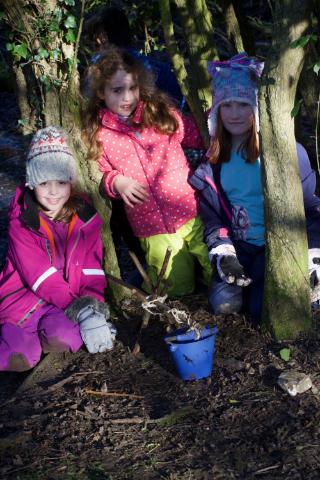
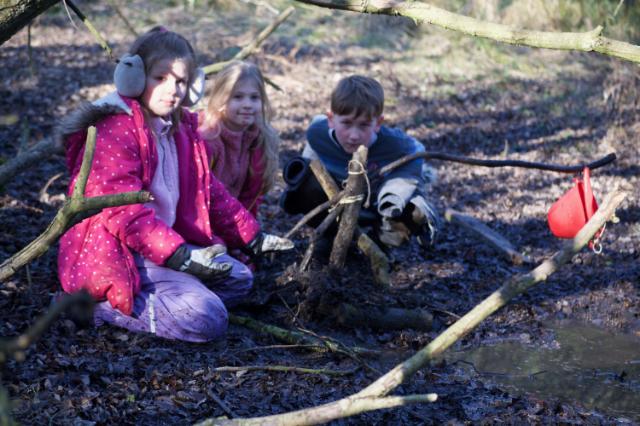
Well being
All sessions began with time in the sit spots which is as good time to work through ideas. Topic based suggestions that the children could think about in their spots included:- mental lists of what they knew about ancient Egypt, differences between sitting in our wood and next to the Nile!
Woodland Paper Making
The Egyptians wove papyrus from reeds, but we included native leaves in the paper we made as no papyrus was available.

Building a fire to cook outside
The children experienced some of the flavours of modern Egyptian food with falafel qnd humus served in flat breads. A well deserved treat after irrigating the crops with water transported by their shadufs.
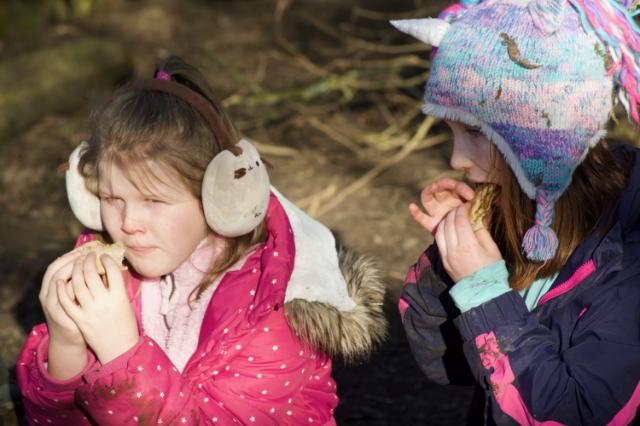

-
The R.S.P.B. Birdwatch
The Birds who live in our wood

The RSPB bird watch, which takes place early each year, makes a great focus for lots of fun, learning and getting close to the inhabitants of our wood.
Looking out for signs of birds in the wood and listening to their calls is a good place to start.
Wandering around the wood, piles of bird droppings can be found, particularly under roosting spots and looking up the children may even be able to decide which branch a bird has perched on. Shed feathers can also often be found. Which bird the feather has come from may not be easy to tell but, the difference between a flight and an insulating feather is easy to distinguish.
Time in the sit spots can be focused on listening out for bird calls – even very young children can learn the difference between birds calling warnings to each other and their straight forward communication calls. Bird song apps for smart phones and ipads, which play the birds’ songs help with learning basic bird calls. Great tits, robins, rooks, magpies, pigeons and pheasants all have distinct calls which children enjoy learning and imitating. Bird song hide and seek is a great way to finish a forest school session.
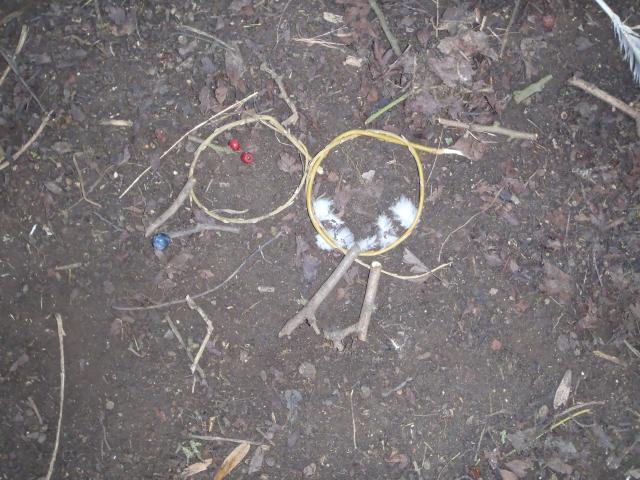
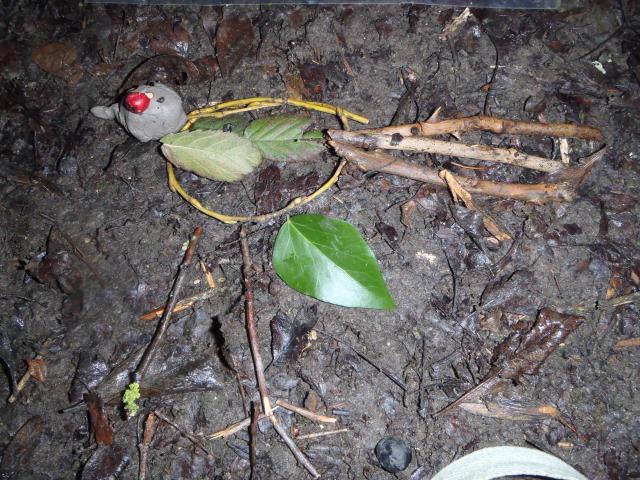
Recognising the birds themselves is helped by pictures or soft toy versions, of which many are now available. Basic bird shapes drawn in chalk on the playground can be used for a game that gets the children running from owl to duck to pheasant to songbird. Making birds from found materials can highlight the names of the different features of a bird.
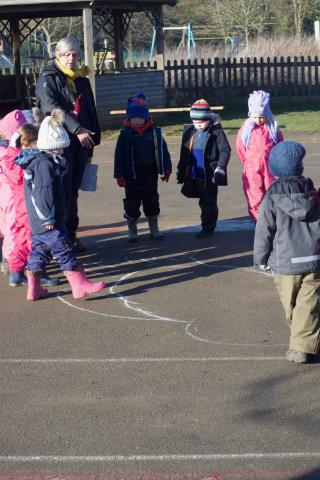

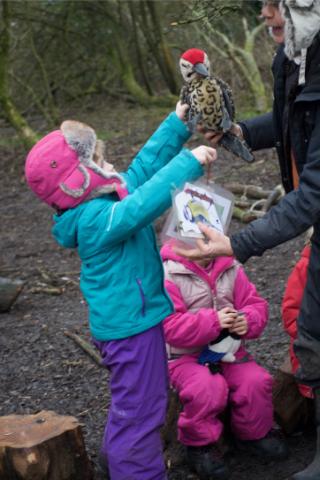
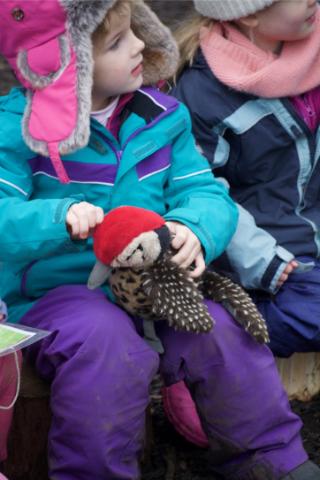
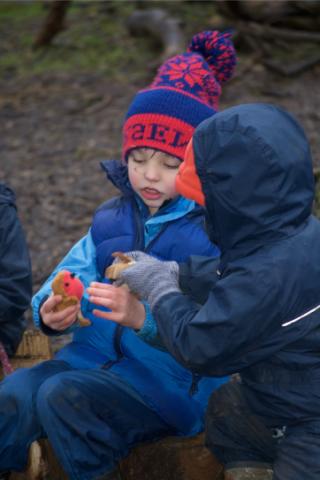

Encouraging the real thing to perch and be counted means setting up a basic bird hide and regularly feeding the birds to keep them coming back. The children have to fill the feeders with the different foods each week and then think about which bird enjoys which food and how their beak is adapted to eat it.
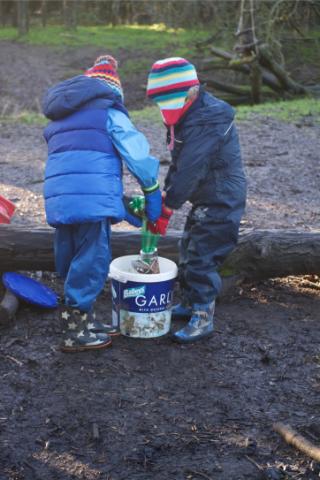

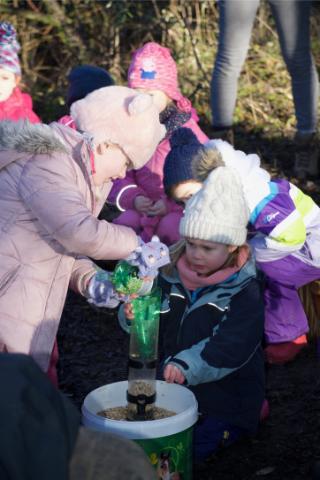
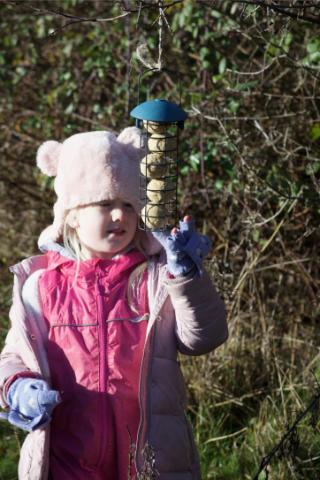
Getting a really close up look gives them practice at using binoculars. Some initial goes with cardboard tubes first help them use the real thing more accurately. Using a toy bird, that will hold ‘really still’ is also ‘handy’.

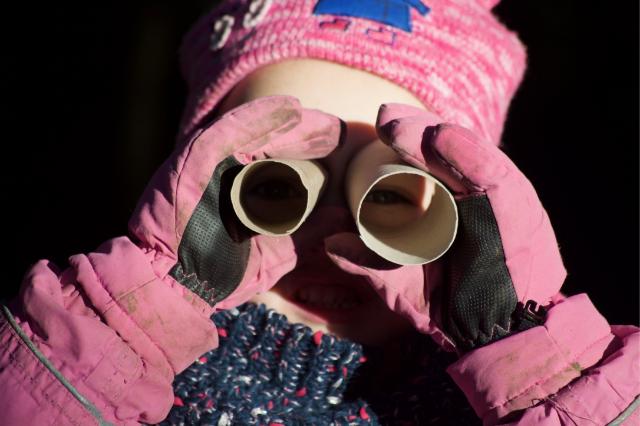

Then the serious business of counting the individual birds and different species begins. The children can learn to use a tallying system and help prepare the totals ready to be sent to the RSPB. a careful look at these totals will reveal a very ‘unusual species’ that was clearly of interest to the young forest schooler watching the hide on recording day!
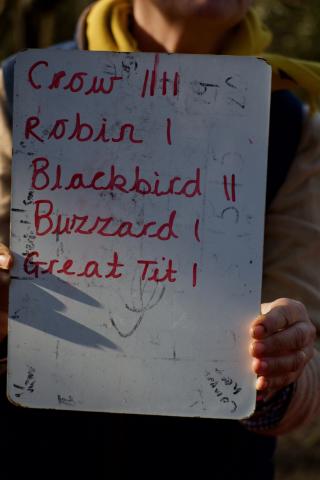
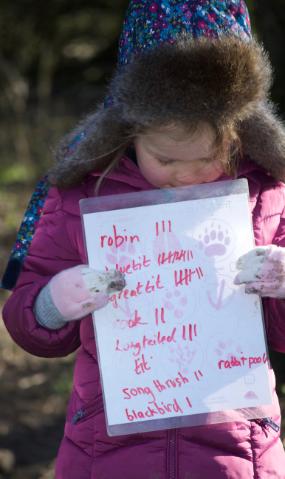
Here are some pictures of the birds we saw.
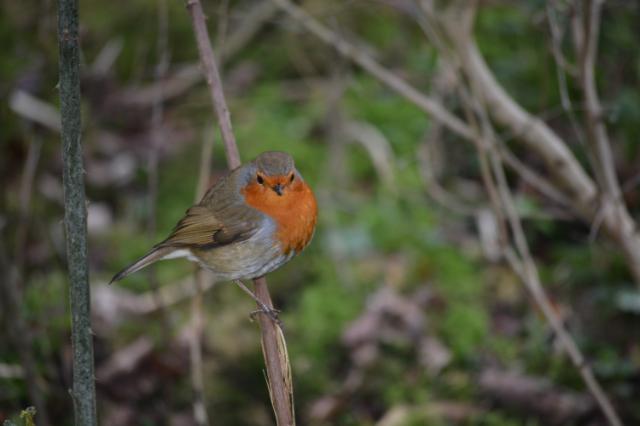
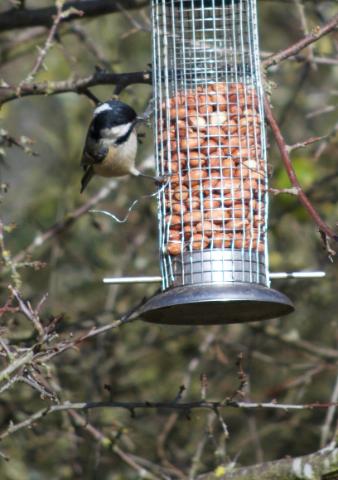
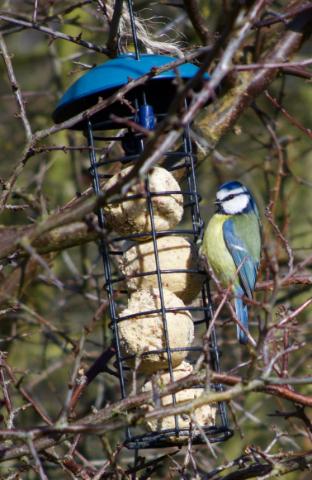
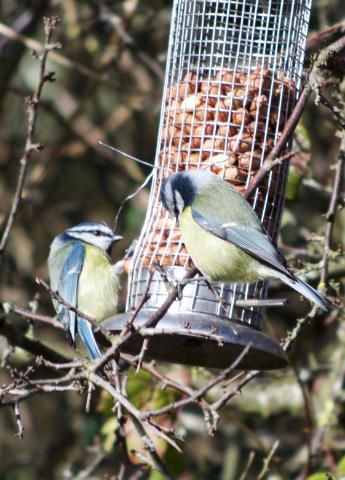
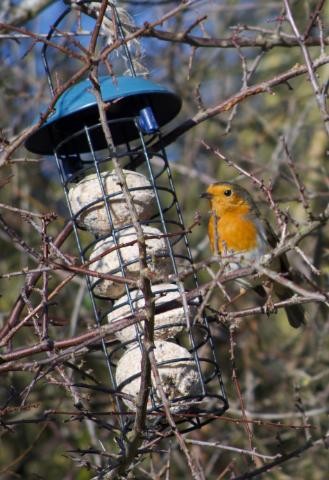

-
The Log Circle
A place where everyone can sit together at forest school is very important.

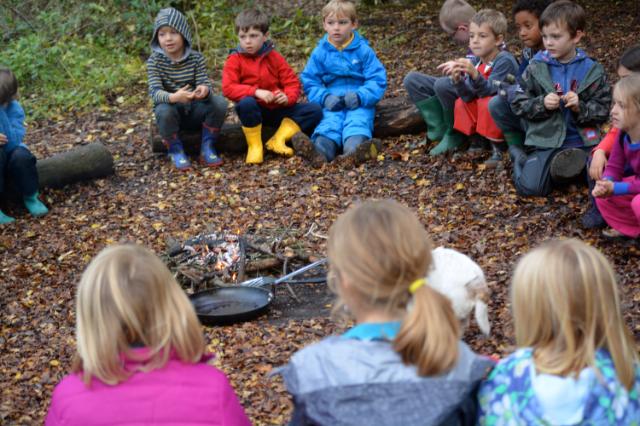
It helps with safety as it is a point the children know to return to when asked and makes checking that everyone is safe, simple.

Sessions can begin and end at the circle. Ideas for the session ahead can be deliberated over and discussed before the children go and pursue their own choices. It is the ideal place to reflect or share a song or story together before we leave for the day.
During the session it makes a great place to have a snack and the logs make good work benches for many forest school activities. As the logs decay, they become treasure troves of mini-beasts and demonstrate to the children the diversity of life in the woods.
From time to time the circle may have to be moved to avoid damaging the woodland floor too much, or new logs may need to be brought in as the old ones rot and become unsuitable. This is hard work but, working together, the children and adults can restore or make a new place to sit in record time, whilst also presenting another team building opportunity.

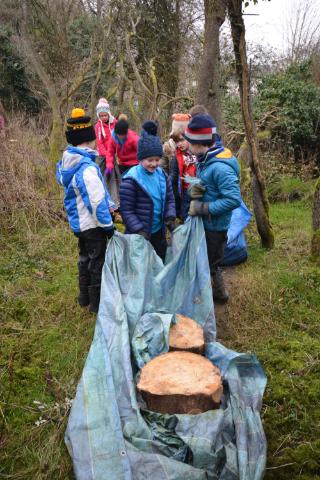



-
Forest School in the Snow
The snow last week gave us lots of different things to do and learn during our forest school and outdoor learning sessions.
There was lots of fun!
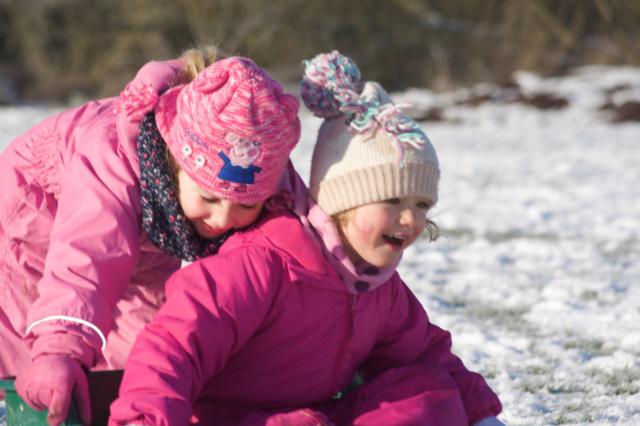

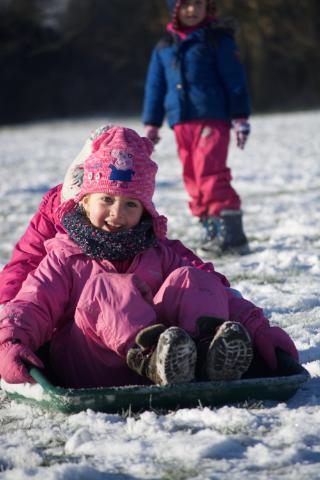
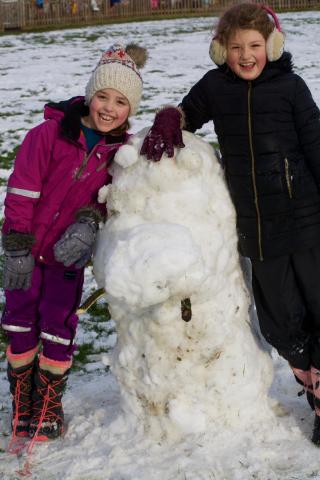
Learning about forces - pushes, pulls and friction.
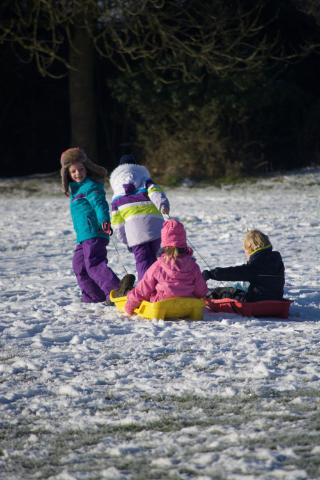
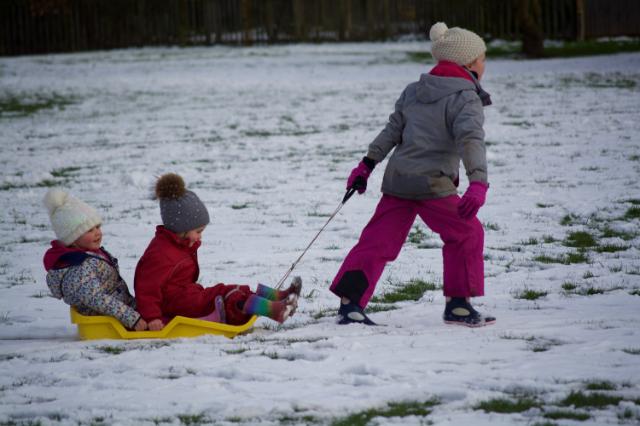

How materials behave.
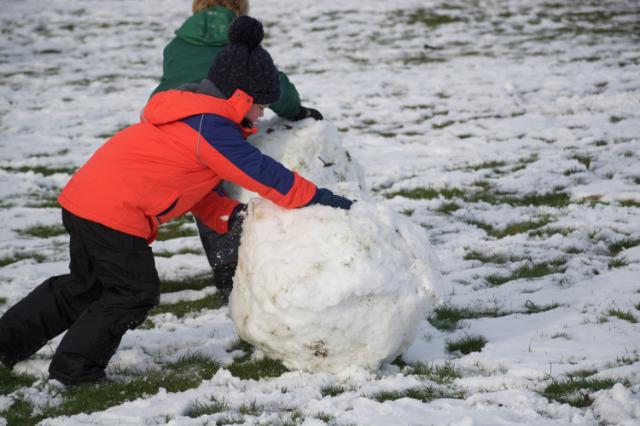
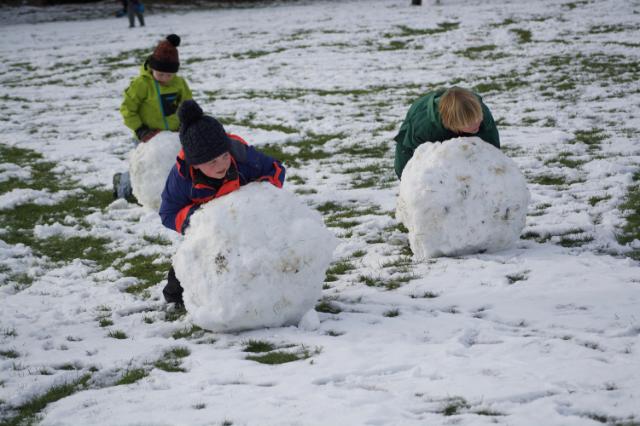
Children worked together.
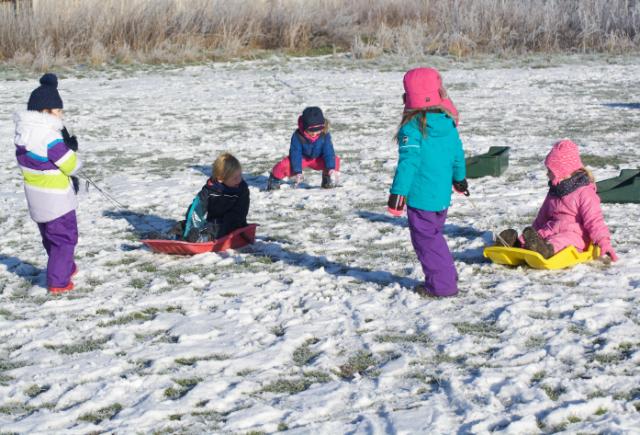
Building structures - snow forts and snowmen.
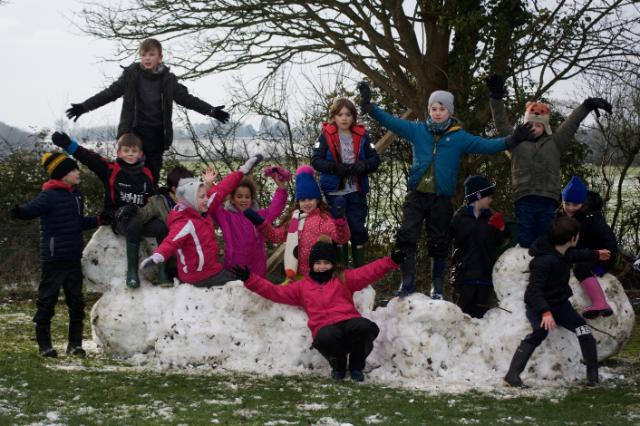
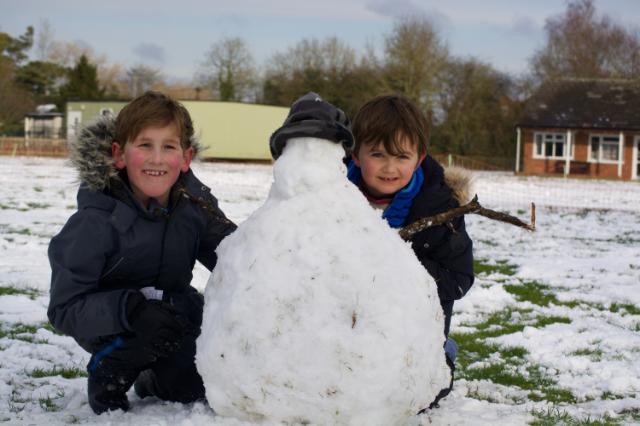
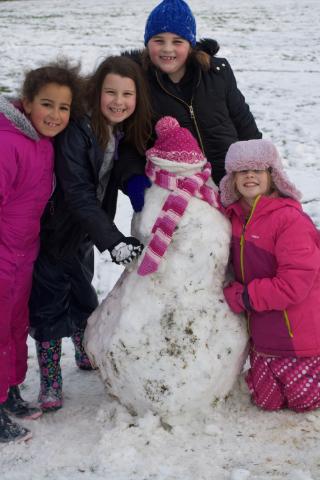
Going tracking - Fox tracks, rabbit tracks, deer and birds hopping, walking and trailing their tails in the snow.
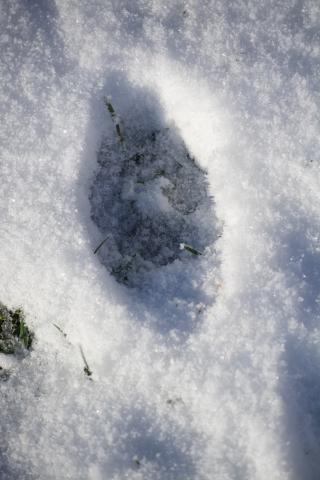
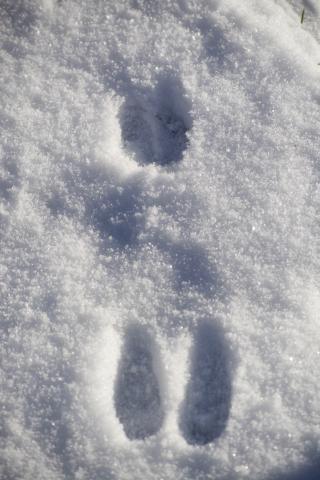

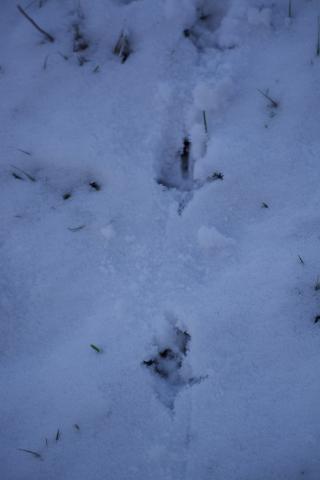
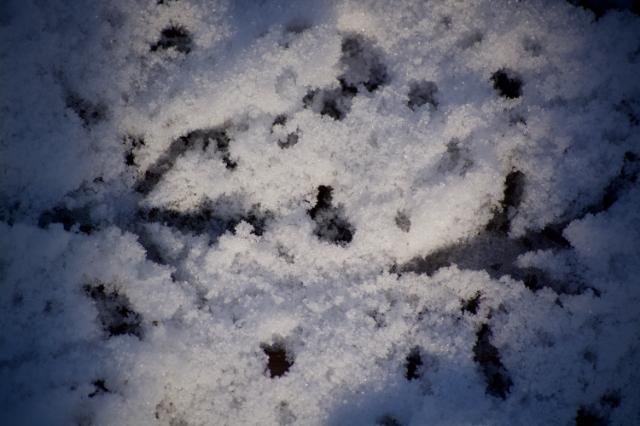
Admiring how amazing the snow makes the natural world look
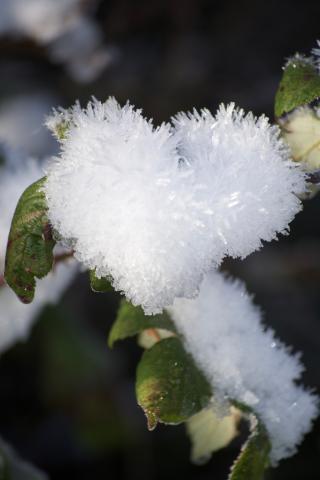
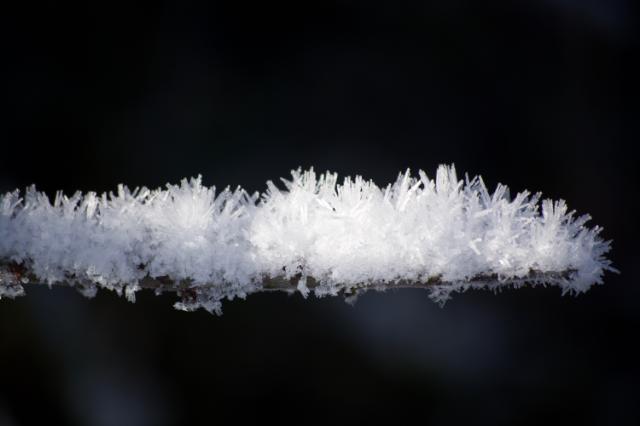
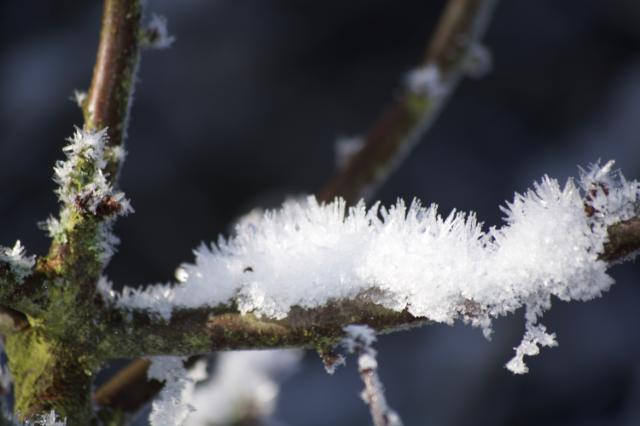

-
Being prepared
It is everybody’s job to help carry what we need for the session to the forest and then make sure nothing is left in the wood when we leave. Things are needed to keep us safe and comfortable (eg handwashing water, paper towels and snack) as well as tools and things to use and play with.
To get to our forest school base everthing must be carried across a field, through a steep ditch, along a winding, woodland path and through a final ditch before we arrive at the circle.
Many things need two pairs of hands to carry them and children and adults have to work together to get everything safely there and back.

As time goes on the children take decisions for themselves about what they want to be doing during sessions and therefore what they will need to take with them. Those chosen pieces of equipment are their responsibility to collect together and return.

-
Children learning how to assess and take reasonable risks
Children learning to assess and take reasonable risks
Even before entering the wood, it is forest school practice to stand back look at the trees and consider how the weather conditions that day may be affecting safety of the forest school site. At all ages the children are fully involved in this process. Young children happily suspend belief and will ask ‘Mr Ashtree, if they may come in and then consider whether the wind is moving the trees in a welcoming manner or telling them to stay away. One child will often go and listen to what the tree says by putting their ear to the trunk (as we know trees only whisper). The listening child will report back to the group whether the tree has endorsed their opinion of the safety of the wood that day. With adult prompting the child may even have a list from the tree of seasonal happenings to look out for that day.
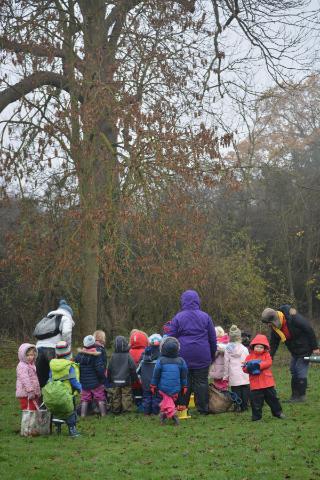
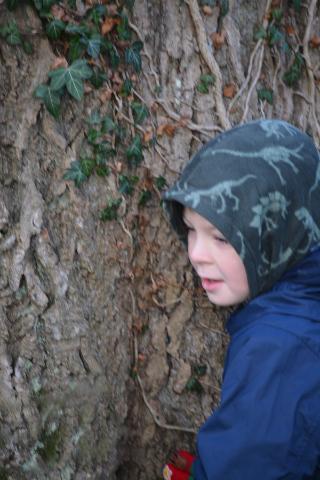
Once inside the wood Forest school sessions guide children how to weigh up the risks involved in many activities.
Questions posed include:-
How thick must a branch be to bear your weight?
How do you know if a branch is alive or dead?

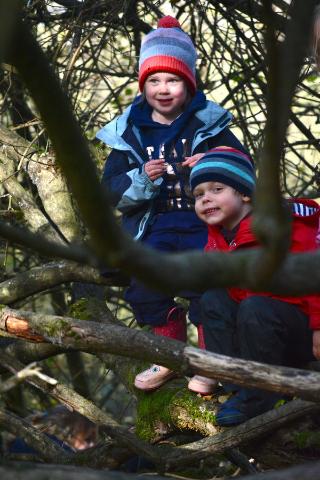
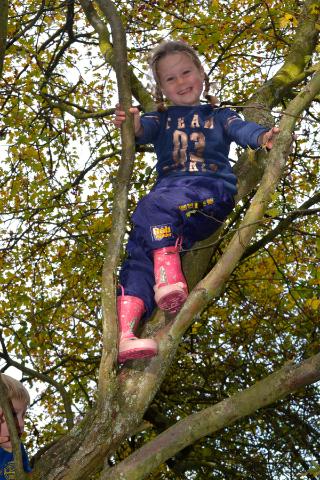
Activities such as climbing a tree, balancing on a log and deciding whether a swing will take your weight all require children to apply acquired knowledge and then decide for themselves whether to proceed. Adults only intervene if the risks involved are unacceptable.

-
Christmas Time at Forest School
Christmas at Forest School

Christmas themed activities for the children to choose during their time at forest school offers lots of opportunities to work together or independently:- practising skills and decorating the wood for the festive season.
Huge twig Christmas trees help them with mastering knotting skills. The trees decorated with berries, cones and stars of gold leaves, encourage the children to stick and join materials together with what’s around them.
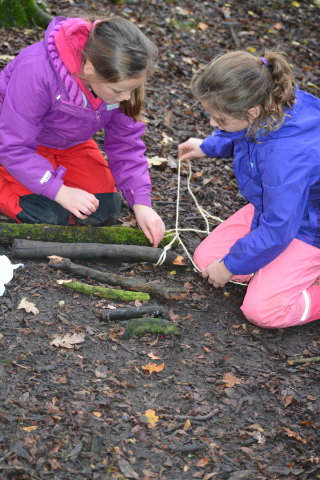

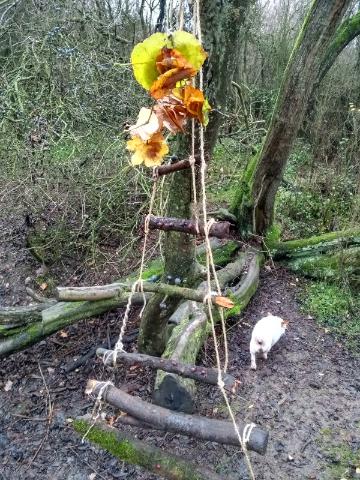

Decorations made from slices of wood use tools.

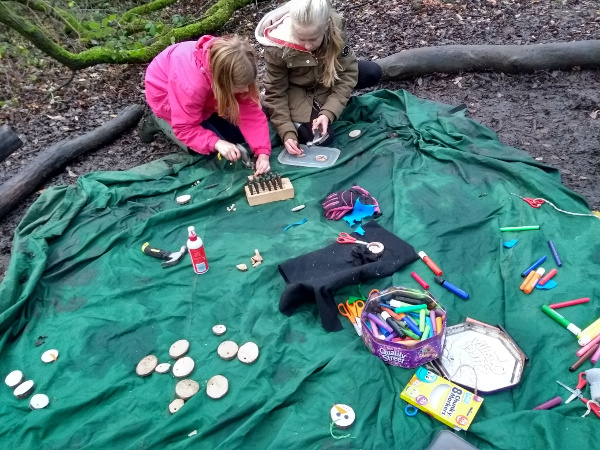
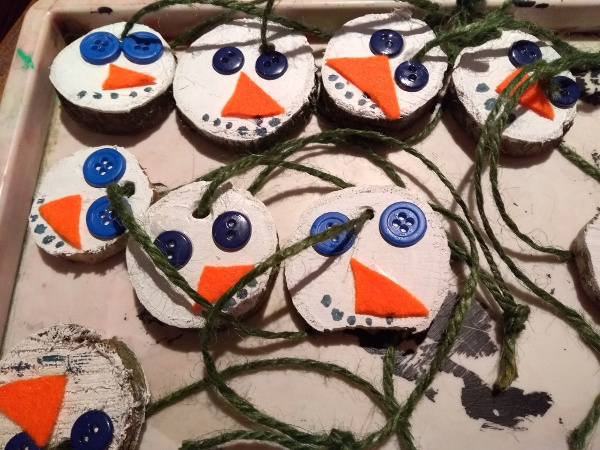
Lighting fires keeps us warm and adds brightness to the winter gloom. A great place to sit around and listen to Christmas stories of robins and fir trees.
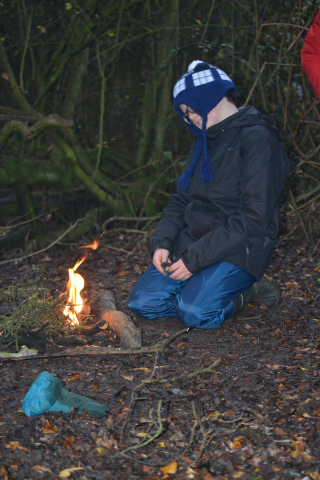
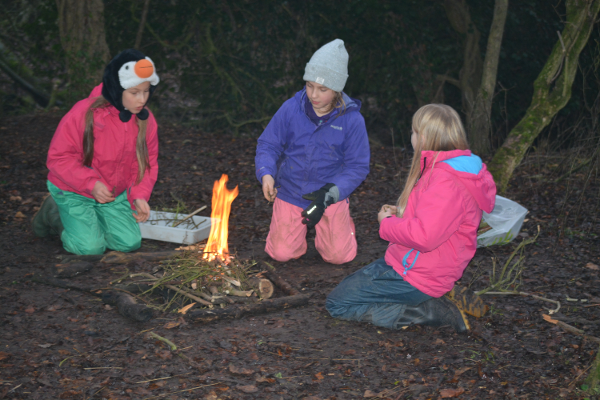
Cooking Christmas pancakes and toasting marshmallows over an open fire – delicious!
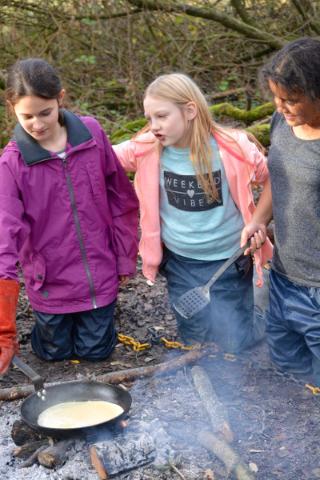
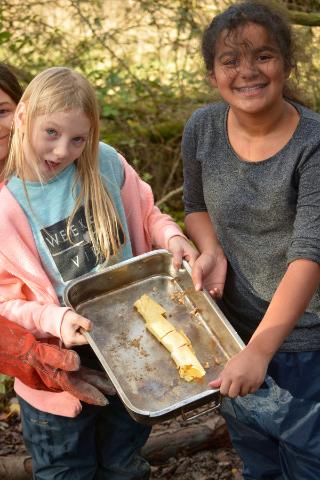

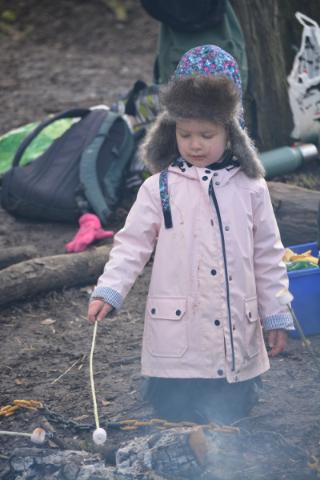

To complete the festive season a visit from Santa is super surprise – although we did suspect he might be in the woods as we found footprints and deer tracks all through the wood. Tracking is great fun, but we all know the reindeer fly and don’t come from our wood!! Instead it is a good time to learn a little more about the native inhabitants to the wood!


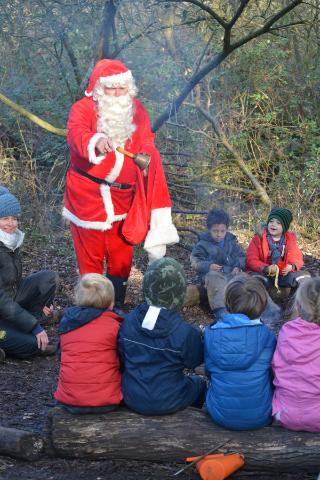
-
Forest School Story Telling
Tell a Story
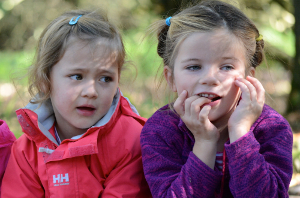
Children love stories and learn lots from good ones. At the end of a session when everybody has been busy and the clearing up is done a shared story helps give a session a reflective conclusion.
Many many of our native plants, animals and insects have ‘folk lore’ stories that can be used to help children understand much about the natural world in which they are playing and vicariously learning.
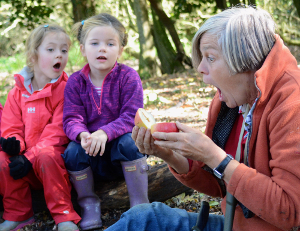
In the age of the internet searching for stories to tell is made easy. There are numerous old stories about our native animals and plants – although many need a little adaption to make them suitable for modern ears and ideas. The internet also throws up stories from other cultures across the world that can be adapted to our English woodland. Particularly rich sources are Native American and Moroccan stories. More contemporary authors whose work is great for retelling and adapting include Margaret Mahy, John Aiken and Ted Hughes.
Stories simply told rather than read allows the teller to engage with children most easily, it really doesn’t matter if the story never comes out the same twice – the children will enjoy telling you it’s different or even that it is wrong this time. Props gleaned from the wood can be useful and often help explain seasonal change. Also a bag of soft toys which are good copies of our native creatures can help stories along visually.
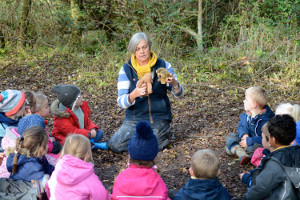

-
Leaf Magic
The late days of September, through October and then early November present wonderful opportunities for children at forest school to creatively use the fabulously coloured autumn leaves. Playing with the leaves also draws their attention to the changes as the season progresses.
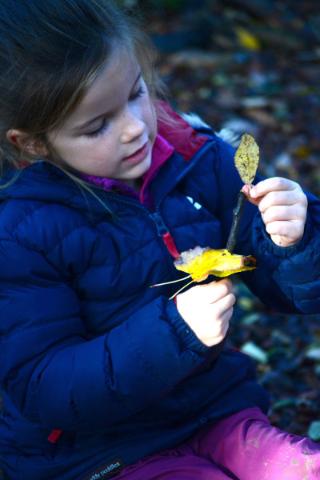
Young children’s observational skills can be honed by finding leaves of different colours and arranging them in ‘stick treasure chests’ laid out on the ground according to the leaf colour. Rectangles of bright red, yellow, orange and green leap out from the brown forest floor on a grey autumn day. Other ephemeral art projects which keep whole classes enthusiastically busy working together to achieve a big result can include putting leaf feathers on huge stick bird outlines arranged on the earth or the scales on a similarly oversized fish out of water on the floor.
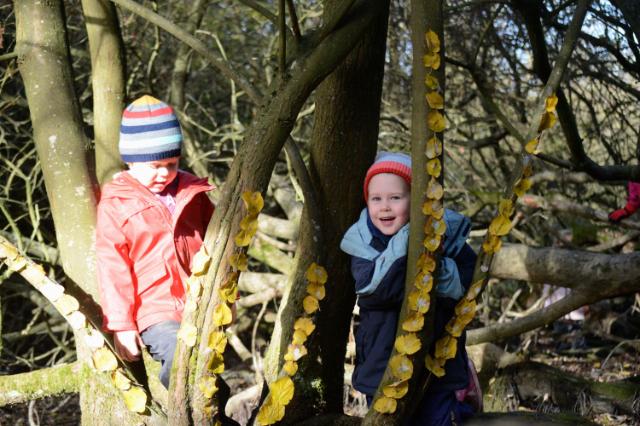
Team work is needed to shuffle a trail in the leaves. A whole class can hold each others waists or shoulders and move conger style through the thick coloured carpet to make a striking ,huge pattern. The children can be encouraged to carefully kick the leaves away to each side with each stride and not let go or the trail will not stand out in the woodland. Spirals work well especially if the whole line turns around once the spiral is made to the middle, let go of the child in front and follow their pattern out to the where is began. Lots of youngsters will tell you they have just made a snail. Continuous crossing trails, such as figures of eight are great fun to race along, following the give way rules set by the children.

Autumn leaves also coincide with Firework celebrations and Remembrance. Flames and fireworks that climb the trees look great and are fun to work together on. Use bright leaves and stick them with scrap clay or clay soil. Commemorative lines and patterns where each leaf represents a number of fallen can help older children appreciate the scale of the loss of lives during world wars. For example a trail or poppy outline five thousand leaves big can represent the fifty million lives lost during WW2 – each leaf representing 10,000 lives.
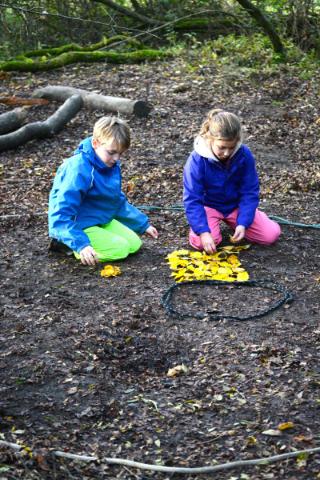


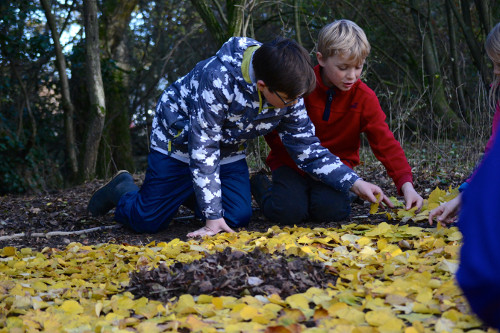



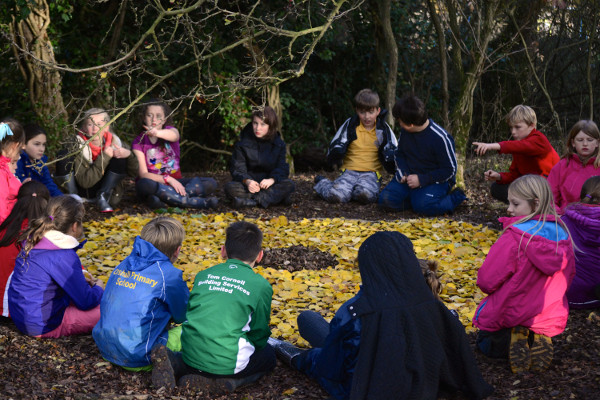
Stories of leaf Magic, do the leaves change colour or were the other colours just hiding until Mr Chlorophyll had to leave?
Leaf storms, cover a foot with fallen leaves, wiggle a toe to be a creeping spider, of move all your toes to be a mouse scuttling through them. Next the wind begins to gentle blow, move the leaves with your hands to create a soft sound as the wind increases move the leaves more and more until the wind picks up a handful and throws them in the air.

-
Berry Picking Time
As autumn draws on the hedgerows bordering the woods and the low bushes growing where the light allows become covered in autumn’s harvest.
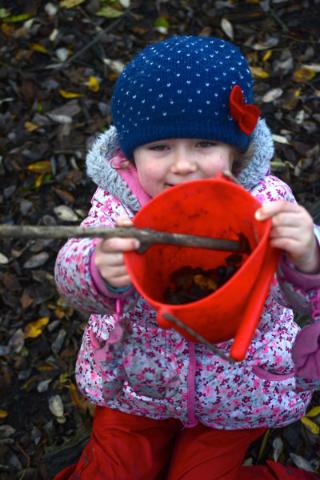

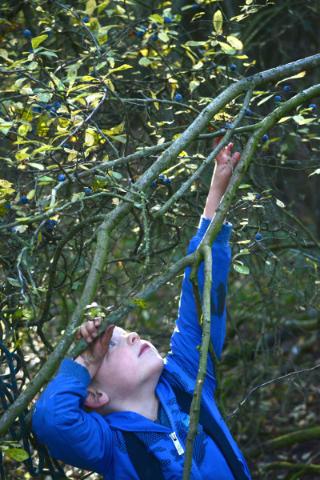
Blackberries, sloe berries and hawthorn berries ‘squish’ and ‘squash’ with varying degrees of success to make ‘berry paint’ or the berries can simply be smeared onto the logs or small pieces paper to make marks ‘pictures’.
There is lots of room for the children to experiment with bashing techniques, suitable paint consistencies and answer questions about the berries, for example does a red berry give a red colour? If there are no brushes available sticks can be frayed at the ends to see which will break into hair like fibres to paint with. Any resulting art work can be displayed on a line of string and held there by hazel pegs made with the help of an adult.
The right berries are also ‘free food’. Blackberries, sloe berries and hawthorn berries washed and cooked together then mashed and pushed through a coarse sieve give a a berry mush that can be mixed with homey to taste and then dried out in the oven to make a tasty ‘berry leather’. Blackberry and apple jelly on toast cooked over the fire embers is another autumn treat. There are lots of recipes for such foraged food on the internet.
Gathering them from week to week helps the children and us see the season as it progresses and any berries left will sustain the birds as the weather gets colder.
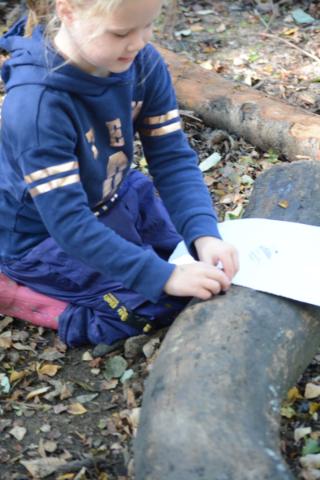
-
Looking after our equipment
Keeping our Things Tidy and Safe
In the woodland environment spades with wooden handles look like sticks and wooden paint brushes even more so. I often wonder what archaeologists of the future will make of their finds at former forest school sites! Forest school practise encourages children to select appropriate tools for themselves and putting them back so they are available next time they need them is skill that is important to learn.
To help us keep track of tools in our forest school we have the “children's’ tree” and the “grown up’s tree!” The children’s tree is the one they can help themselves from. They are actually a couple of hawthorn trees very close to our log circle.
At the same time as we ask our trees if it is safe to enter the children are encouraged to look carefully at what they have been asked to carry to the wood and decide whether it’s ‘home address’ is the children’s tree or the grown ups tree. Once in the wood the home addresses of the children’s equipment can be practised:-
The Paintbrushes
In the Orange Bucket
Next to the Children’s Tree
The Buckets
Empty
Piled up
Beside the Children’s Tree
The children can even think about their own home address and practise that – something that many children find tricky in the modern world, where they are often more likely to know their email address than how the post finds their house.
This system is not perfect and mud encrusted spades do go missing – but encouraging everyone to help things find their way home does help.

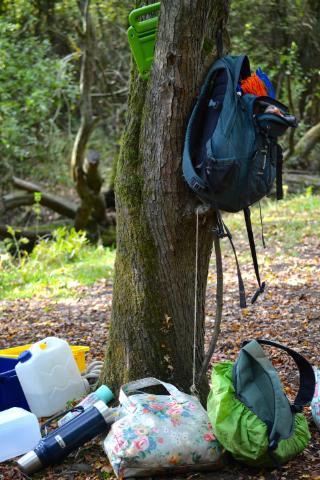
Moreover making sure everything finds its way back to its home address is a task for the whole group collectively, building skills in working with others, communication and negotiation when transporting items that require more than one pair of hands!
-
Sit Spots
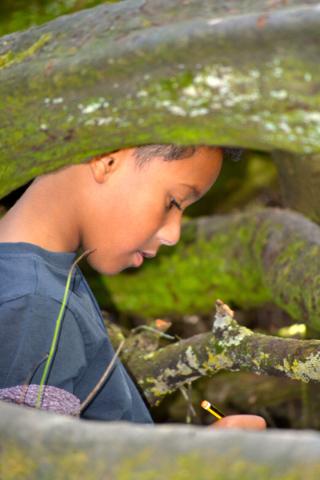
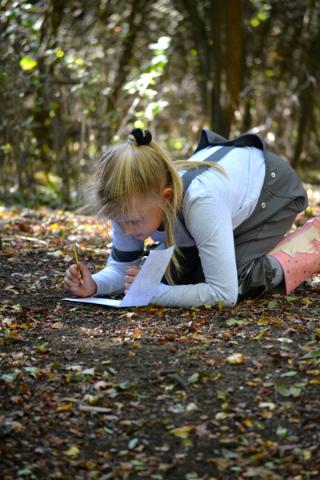

Modern life moves so fast and we rarely spend time sitting all alone just listening or watching to what is going on around us. Finding their own small space for themselves in the wood where they will just sit for a short time allows children to slow down and watch and listen to a little bit of the natural world of the wood going by’.
My experience has taught me the benefits to the children over time are many fold. I am always struck by the calming, focussing effect it has on the class of excited and slightly over boisterous children who have nosily arrived for forest school. Indeed perhaps everybody's’ well-being, adults and children alike, is helped by a few quiet moments.
Learning to pay attention to what’s happening in the present moment in the natural environment, helps lay a foundation for children to develop the capacity to observe their own thoughts, feelings and internal experiences from a non judgemental position. These mindfulness skills can be helpful in fostering emotional resilience and well being.
Over time children learn to observe changes and begin to make connections about the natural world, it is so much more fun for children to learn these connections at first hand, as they observe things in their spot changing from week to week.
Setting up sit spots with the children isn’t tricky but has to be done it stages. It takes time to tune in to the woodland world and can even be a little scary going off to find your own space. Children need help to find a spot for themselves which is just for them, not too close to their peers to cause distractions but not so far as to make them too isolated.
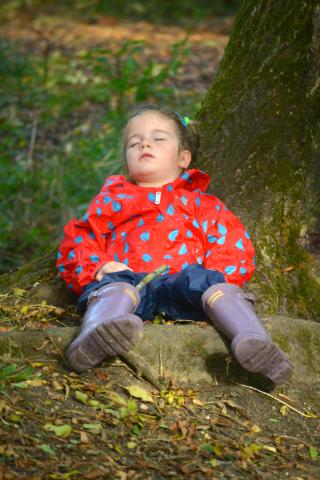

Children need help to hone their looking, listening and touching skills. For the first couple of times of sitting I may keep the children together and we will practise just listening, we can listen out for certain sounds, then simply looking, up, down, close far away. Sometimes closing their eyes for the listening part helps.
Once the children are off to their own spot it may be appropriate to give a focus for the sit spot session for example how many different bird calls can you hear? Can you identify ones that are warning sounds, ones that a mating calls or just the birds simply telling each other where they are?
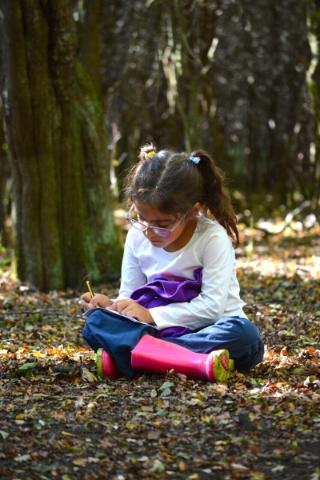
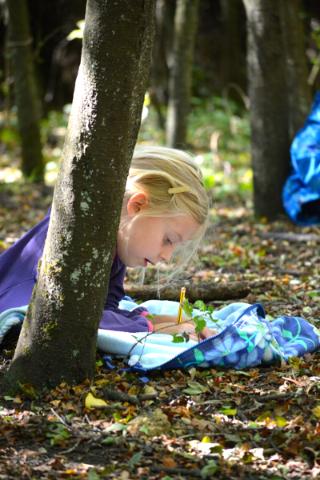
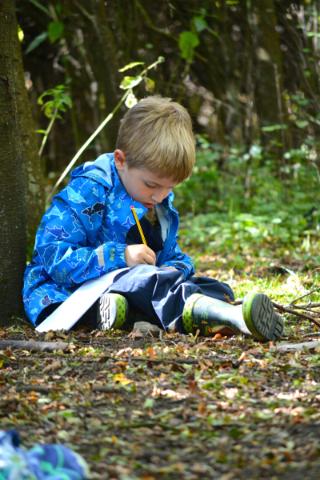
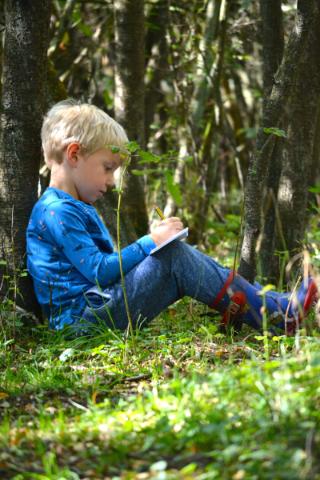
Just’ chilling’ in a sit spot is, in my opinion, is a valuable skill to learn, but sit spots can be used to support the curriculum in many ways. Often forest school sessions become more focused for older children who are experienced forest schoolers. Keeping a log of what is happening from week to week can be fun. A small pad for each child and a pot of pencils are all that is needed – I usually leave the children to choose whether they write or draw or do nothing at all. Wind blowing through a wood can allow children to imagine they are somewhere else. For example a Year one class doing a topic on pirates at sea to were able to interpret the wood as a raging sea, it is amazing what they can hear going on in the oceans of their imaginations! The calming peaceful experience of their sit spot allowed a members of a Year 5/6 class to consider how terrifying being on the deck of the Titanic would have been in comparison. Habitat work allows children to sit and listen and look at the creatures the wood is home to.
Many children and, it has to be said the adults accompanying them, find sitting alone very tricky to begin with. However, they manage to sit for longer and longer periods – up to about fifteen minutes and the rewards are often manifold. The thrill the reception class got when a deer wandered through, they had been so quiet the deer had entered up wind and not smelt or spotted the children. The wide eyed look of the four year old sitting in her spot after the rain and a worm emerged beside her welly. Very often groups will not want to stop and even want to finish the session with another go in their sit spot.
